63 Creative Sensory Activities for 1 Year Olds
One-year-olds are like tiny scientists, eager to explore the world around them!
Sensory activities help babies learn through touch, sight, sound, smell, and taste.
These fun experiences boost brain development and help little ones understand their environment.
Simple activities, such as playing with textured toys, splashing in water, or squishing soft playdough, can keep your toddler engaged for hours.
Sensory play also helps develop fine motor skills and hand-eye coordination.
The best part?
Most sensory activities use everyday items you already have at home.
Your kitchen, bathroom, and living room are full of sensory treasures waiting to be found!
Ready to turn your home into a sensory wonderland?
Let the messy magic begin!
Sensory play includes any activity that stimulates a child’s senses.
These activities engage one or more of the five senses: touch, smell, taste, sight, and sound.
When babies explore different textures, colors, sounds, tastes, and smells, they build nerve connections in the brain.
This helps them learn about the world around them.
Sensory play can be as simple as squishing mud between fingers or as structured as playing with musical toys.
For 1-year-olds, these experiences are not just fun.
They are building blocks for language development, motor skills, problem-solving, and social interaction.
Through sensory play, toddlers learn how things work and develop confidence in their abilities.
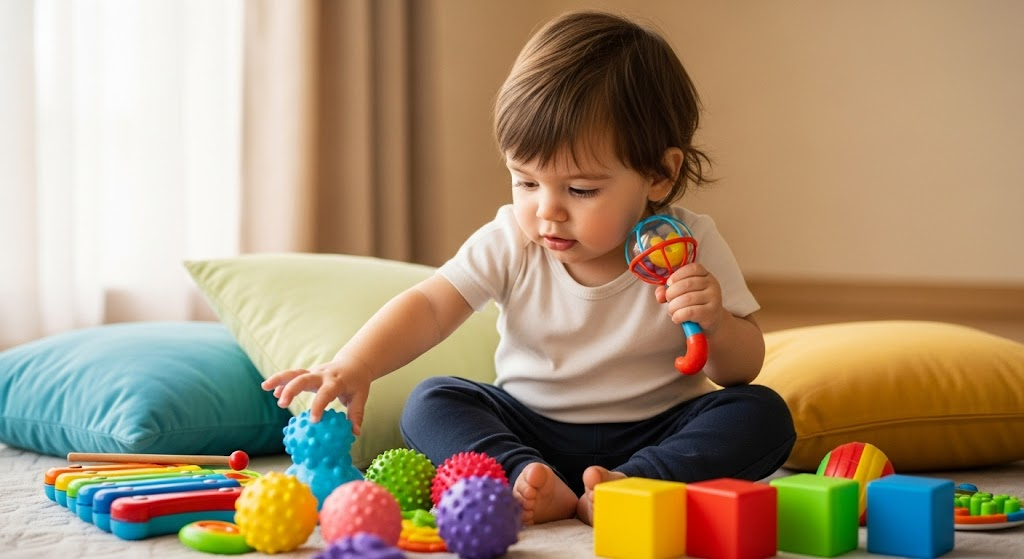
Sensory play is crucial for 1-year-olds as they rapidly develop skills.
It strengthens fine motor skills when they pick up small objects or squeeze squishy toys.
Their brain makes important connections when they explore different textures, colors, and sounds.
This helps with problem-solving and thinking skills.
Sensory activities also build language as babies learn words like “soft,” “loud,” or “sticky” through experience.
When they play with sand, water, or musical toys, they learn cause and effect.
These hands-on experiences help them understand how the world works better than any explanation could.
Sensory play also calms and focuses many children, helping them process their busy world in a way that makes sense to them.
These sensory activities are made with safe ingredients your 1-year-old can touch, taste, and explore.
They help build fine motor skills, encourage curiosity, and support early brain development.
Best of all, they’re worry-free for parents since everything used is gentle on tiny tummies and easy to clean up afterward.
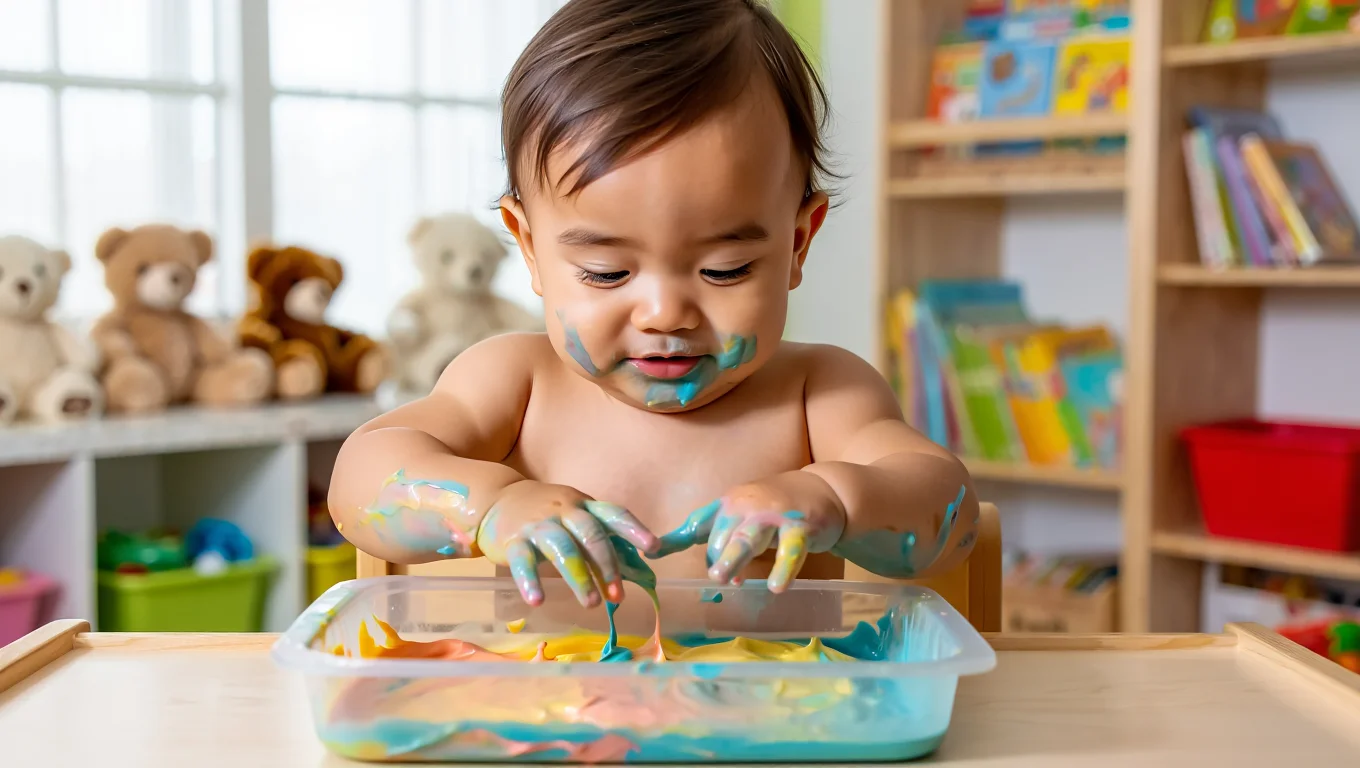
Spread plain yogurt on a tray or plate. Add a few drops of food coloring.
Let your toddler swirl the colors with their fingers. It’s cold, smooth, and fun to touch.
If they put it in their mouth, that’s okay, it’s safe to taste.
This activity helps build hand control and early creativity through texture and color play.
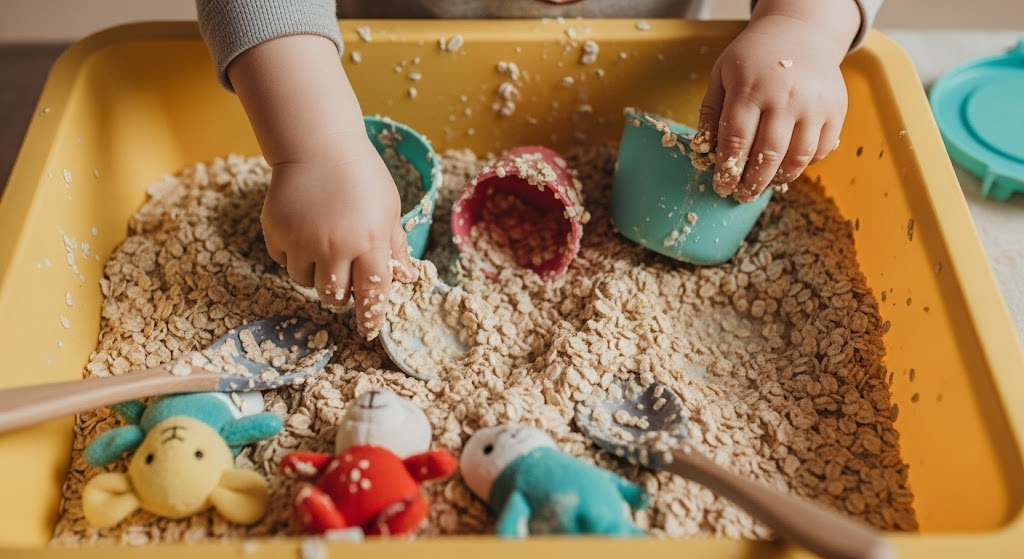
Cook plain oatmeal and let it cool. Scoop it into a shallow tray or bin.
Your toddler can squeeze, scoop, and smear the oatmeal using their hands.
You can even hide soft toys or safe tools inside for them to find.
The warm, gooey feel is exciting and totally safe to taste.
It builds sensory awareness and hand strength.
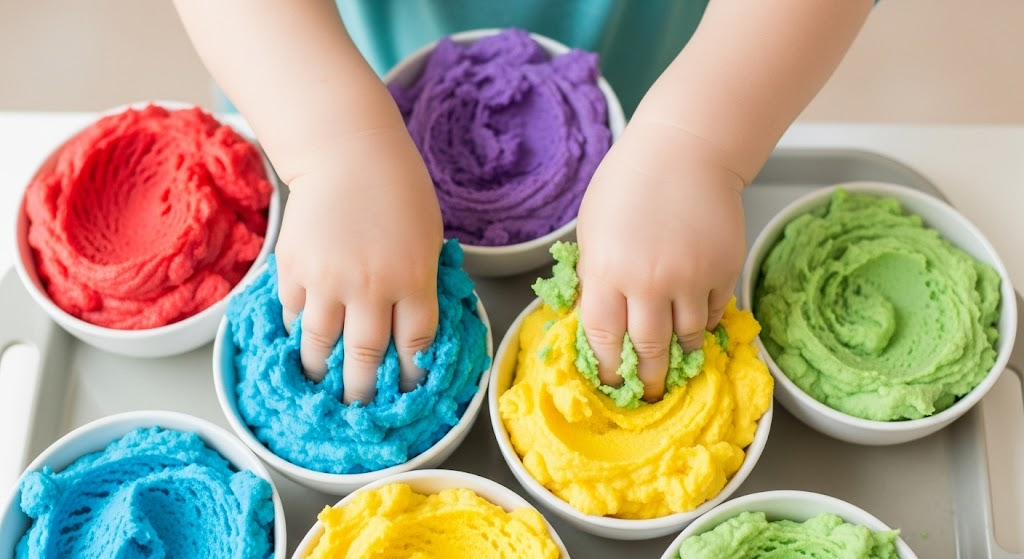
Make mashed potatoes and divide them into different bowls.
Add food coloring to each bowl and mix until well combined.
Once cool, set them out in a tray and let your toddler mash, mix, and explore.
The texture is smooth and soft, perfect for little hands.
It’s completely safe if they take a bite while playing.
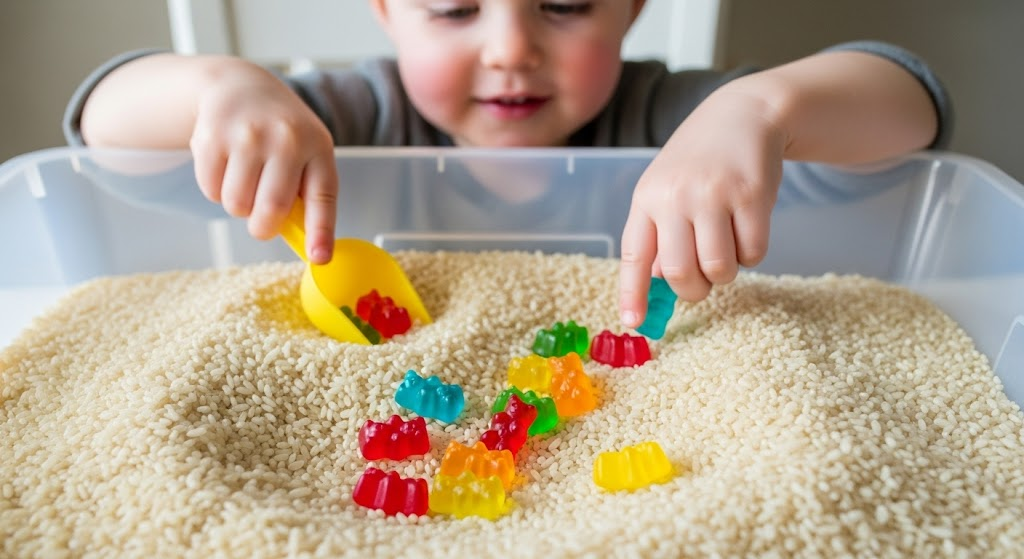
Pour dry rice into a bin and hide a few gummy bears underneath.
Your toddler can dig through the rice using their hands or a scoop to find the treats.
The contrast of hard rice and soft candy makes it more interesting.
Once they find a gummy bear, they can eat it too! This builds focus and fine motor skills.
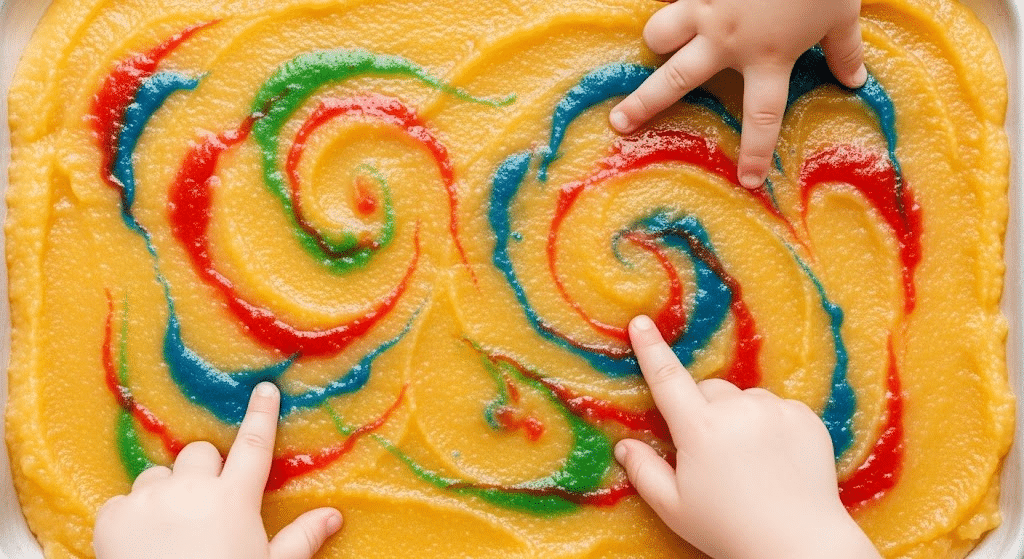
Spread a layer of applesauce on a flat tray.
Add drops of colorful fruit puree or food coloring.
Let your toddler swirl the mix using their fingers. It’s smooth, sticky, and easy to taste.
They’ll enjoy seeing the colors blend as they draw and doodle.
This activity boosts creativity while being completely safe for curious little mouths.
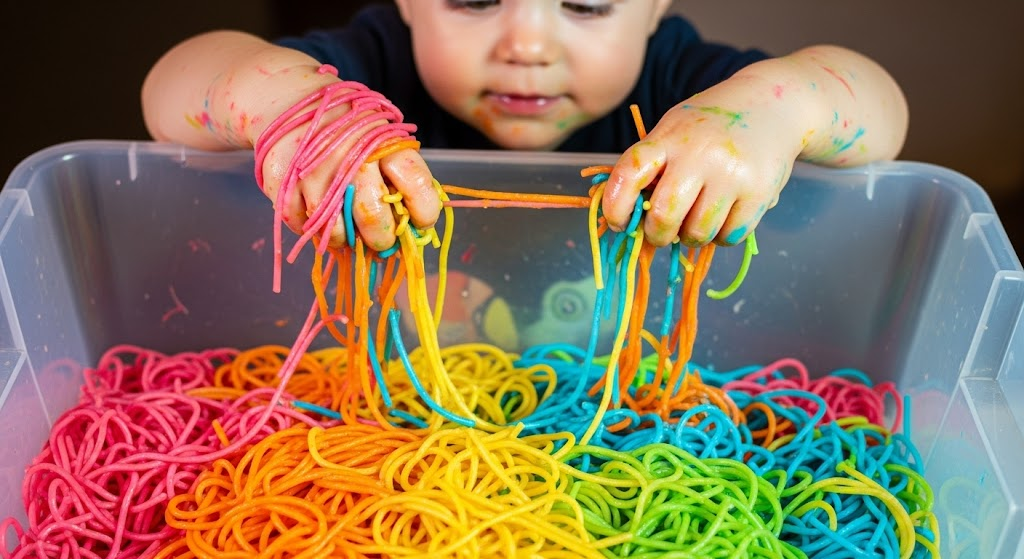
Cook a batch of spaghetti noodles and let them cool.
You can add a bit of food coloring to make it more exciting.
Place the noodles in a bin and let your toddler pull, stretch, and squish them.
It’s a fun, slippery texture to explore.
And if they eat a noodle or two, it’s totally fine.
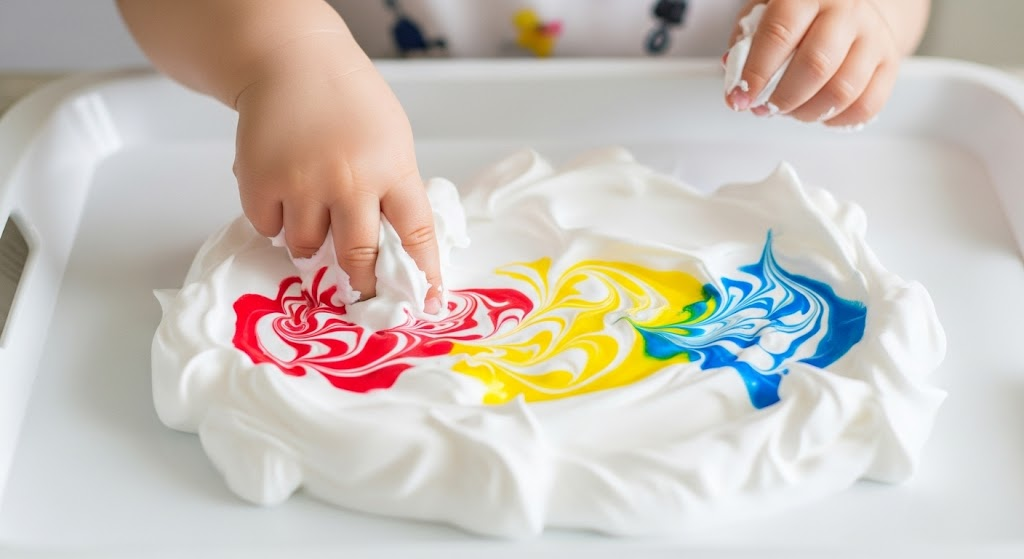
Spray whipped cream across a clean table or tray.
Let your toddler spread it, tap it, or draw with their fingers.
Add a drop of food coloring for fun designs.
The creamy texture is soft and fluffy, and it’s completely safe to lick.
This activity lets them explore without mess and keeps cleanup super easy.
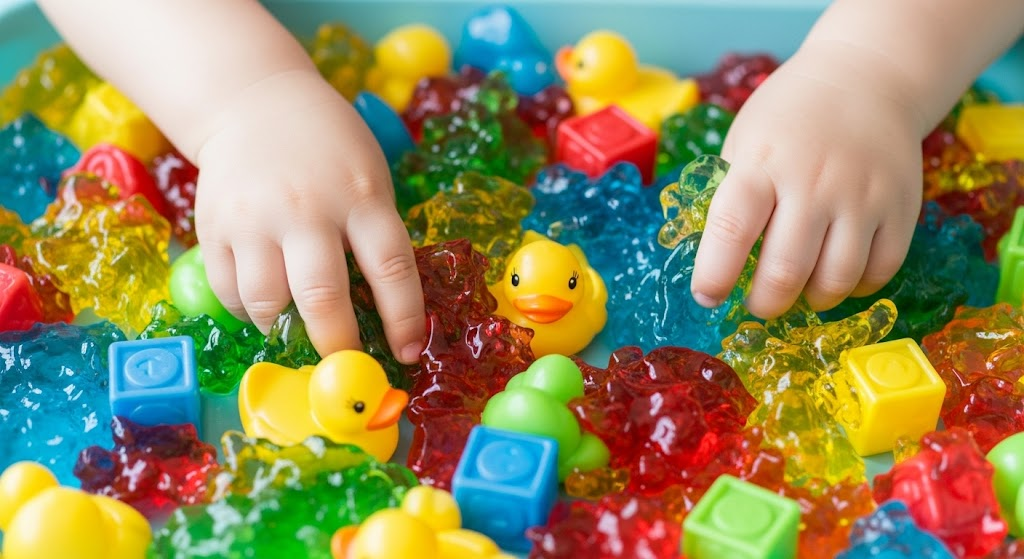
Make jello using a baby-safe recipe and let it set with small toys inside.
Once firm, let your toddler dig through it to find what’s hidden.
The wobbly feel makes it fun and silly. Since the jello is edible, they can taste it too.
It helps improve coordination and turns snack time into a playful experience.
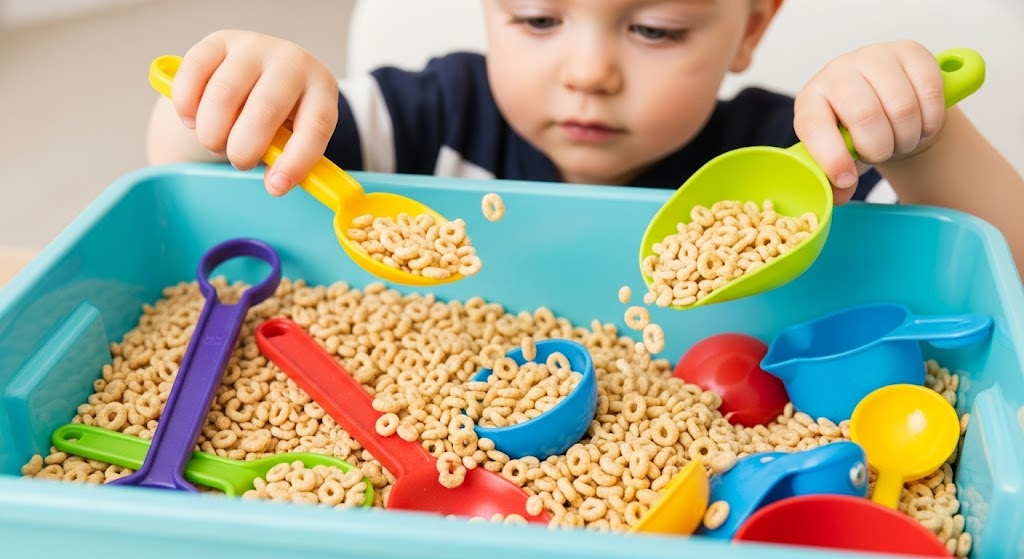
Fill a plastic bin with dry cereal like O-shaped oats or puffed rice.
Add plastic spoons, measuring cups, or toy scoops.
Your toddler can dig, pour, and explore while tasting along the way.
The different shapes and crunchy sounds make it more engaging.
This activity encourages fine motor development and early counting through playful pouring.
These sensory ideas are perfect when you want fun without the mess.
Each activity keeps things clean while still giving your 1-year-old plenty to touch, shake, and explore.
Most use sealed bags, bottles, or tidy materials.
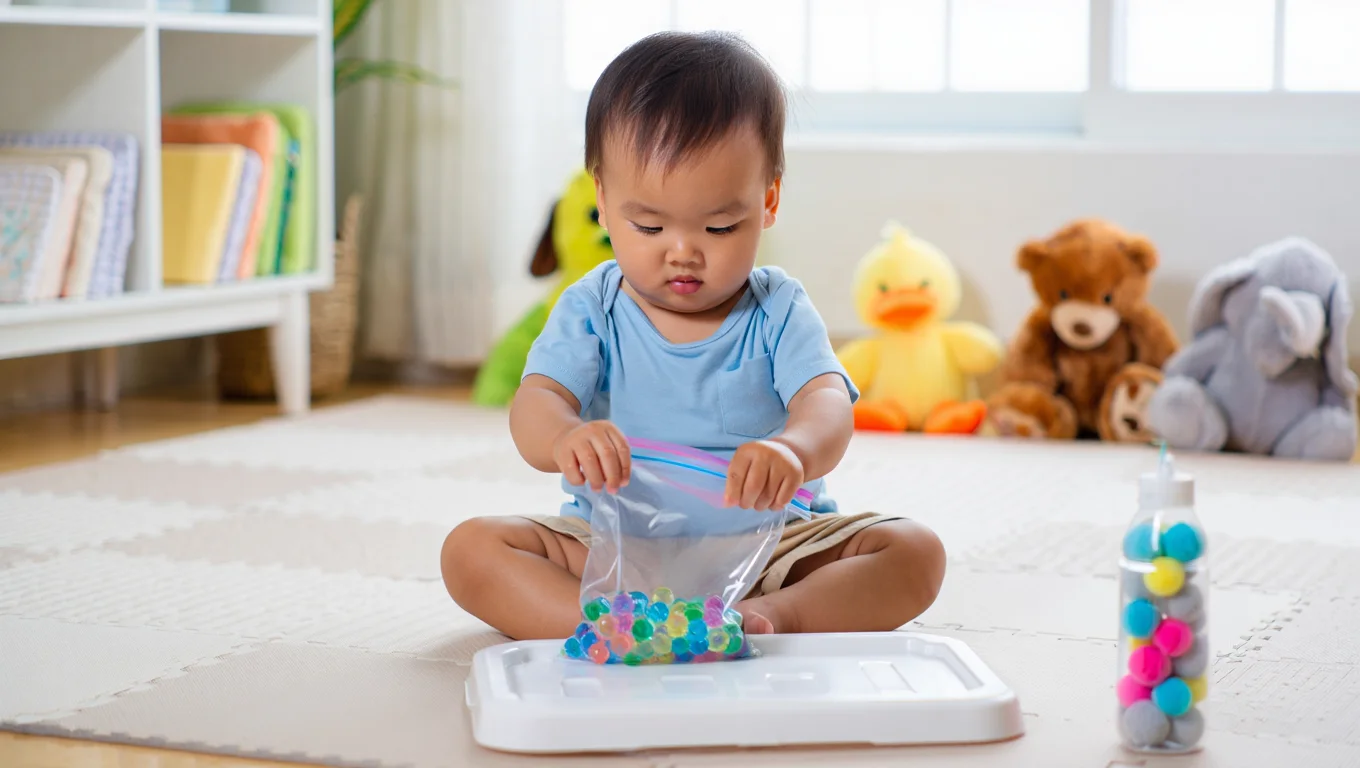
Place fully soaked water beads into a strong ziplock bag.
Seal it tightly and tape it to a tray or table.
Let your toddler press, squish, and move the beads around through the bag.
It’s fun to feel the bumpy texture without getting wet or sticky.
The colors are bright, and the activity is completely mess-free and safe with supervision.
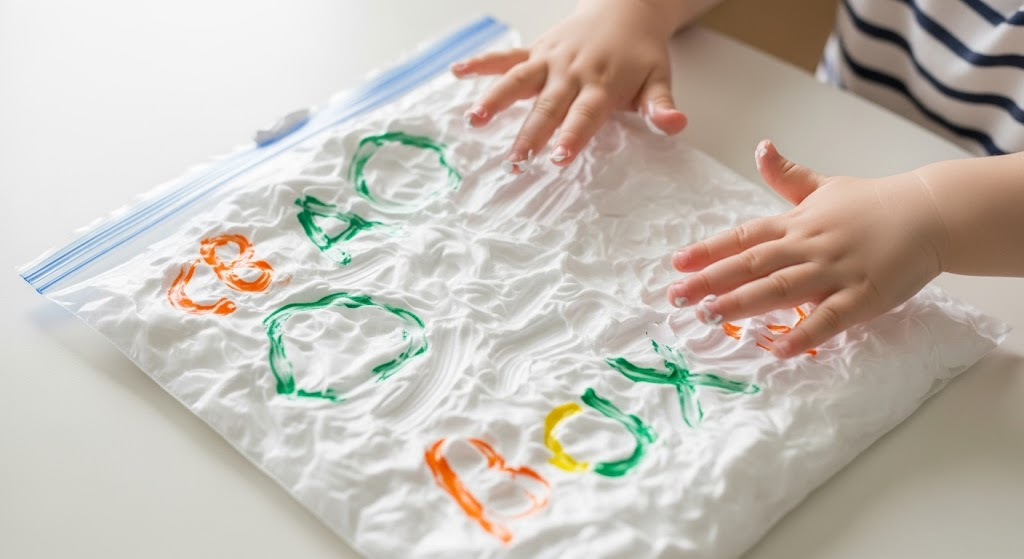
Squirt shaving cream into a ziplock bag and seal it well.
Use your finger or a Q-tip to draw letters, numbers, or shapes on the outside.
Your toddler can push and trace with their hands. It feels soft and smooth through the plastic.
There’s no cleanup since everything stays inside the bag.
It’s perfect for early writing practice and tactile fun.
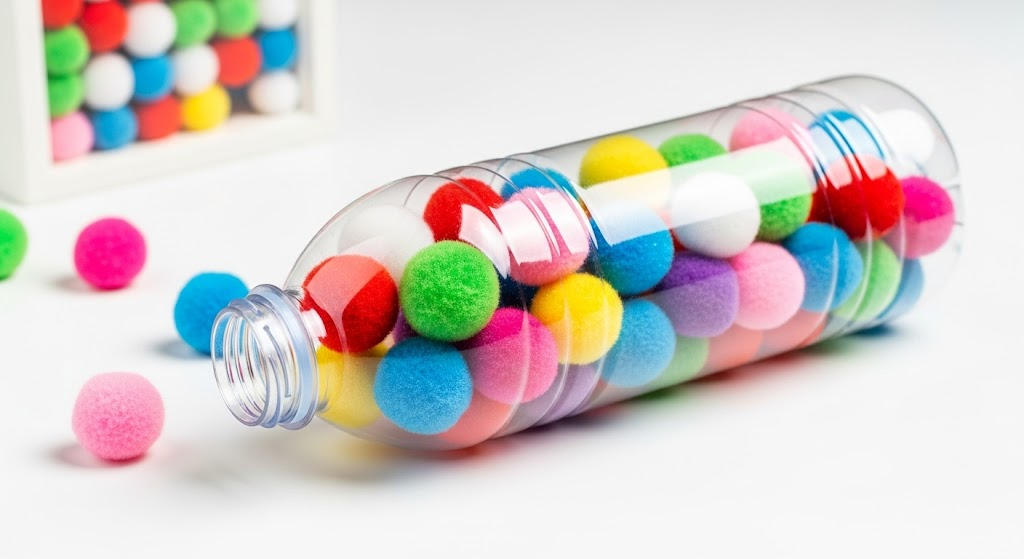
Drop colorful pom-poms into an empty clear water bottle.
Your child can shake, roll, or turn the bottle to watch the pom-poms move around.
The soft texture and bright colors make it an exciting experience.
It’s quiet, safe, and great for keeping kids busy.
This activity builds visual tracking skills and fine motor strength without any mess.
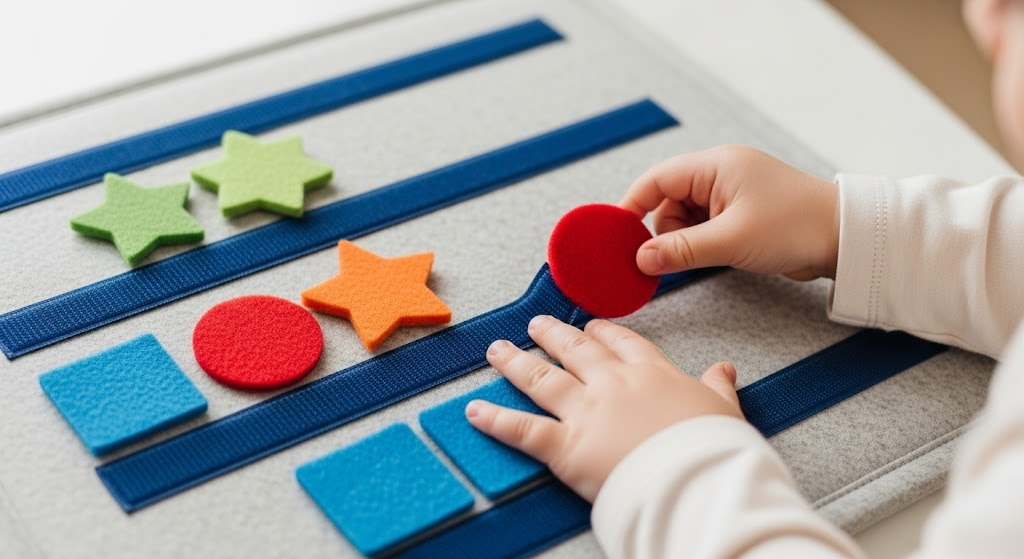
Stick strips of Velcro onto a board or stiff fabric.
Attach small felt shapes, fabric pieces, or soft toys.
Let your toddler pull them off and press them back on.
The pulling and sticking feel fun and satisfying.
It’s also great for building hand strength and coordination.
Everything stays neat and in one place, no cleanup needed.
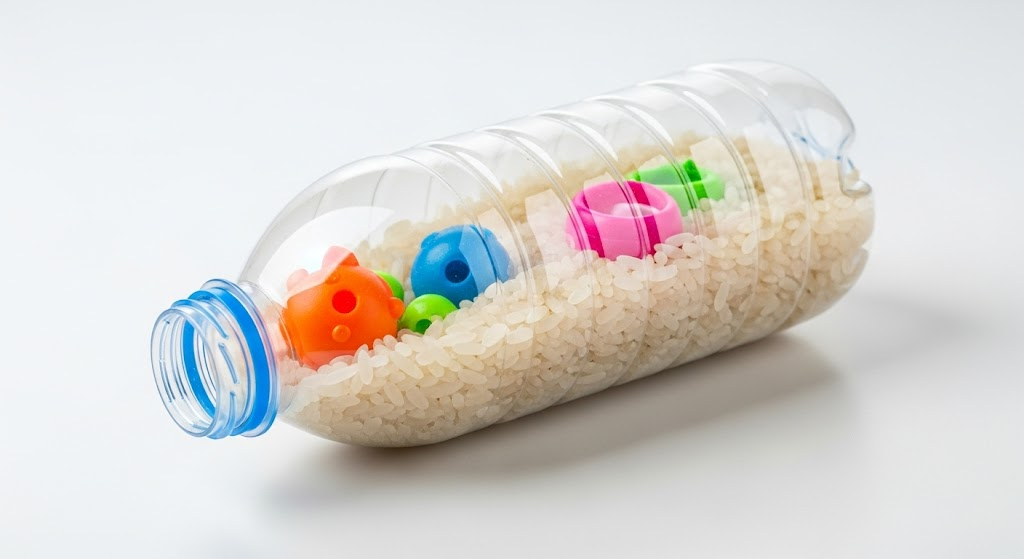
Fill a clear plastic bottle with dry rice and seal the lid tightly.
You can add a few small toys or beads inside for extra fun.
Let your toddler shake and roll the bottle to hear the sounds and see things move.
It’s like a homemade musical toy that’s simple, quiet, and clean.
Great for sensory sound play.
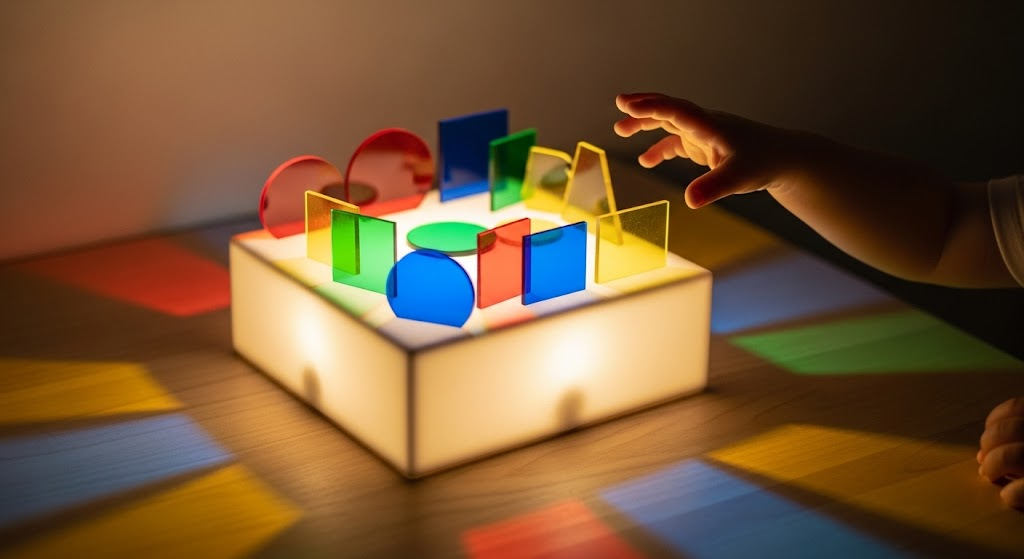
Use a light box or place a flashlight under a clear bin lid.
Give your toddler colored plastic shapes or cups to place on top.
As the light shines through, the colors glow and change.
It’s beautiful to look at and encourages sorting by color.
The setup remains dry and clean while offering a lot of visual stimulation.
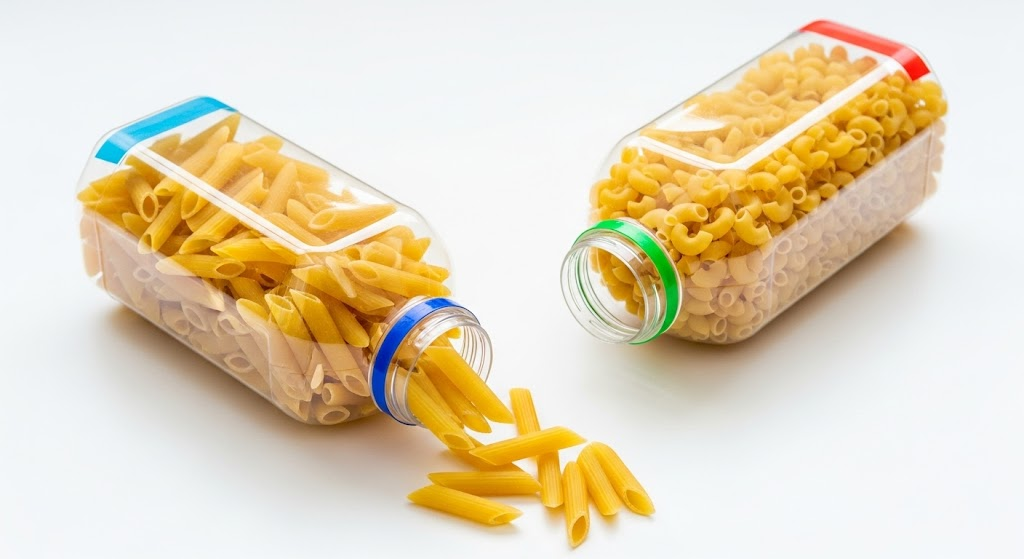
Pour dry pasta like penne or macaroni into a clear plastic bottle. Seal it well with tape.
Your toddler can shake it like a rattle and enjoy the sound.
Try making two with different pasta shapes for variety.
The noise is gentle, and the bottle stays sealed, so there’s no mess to clean up afterward.
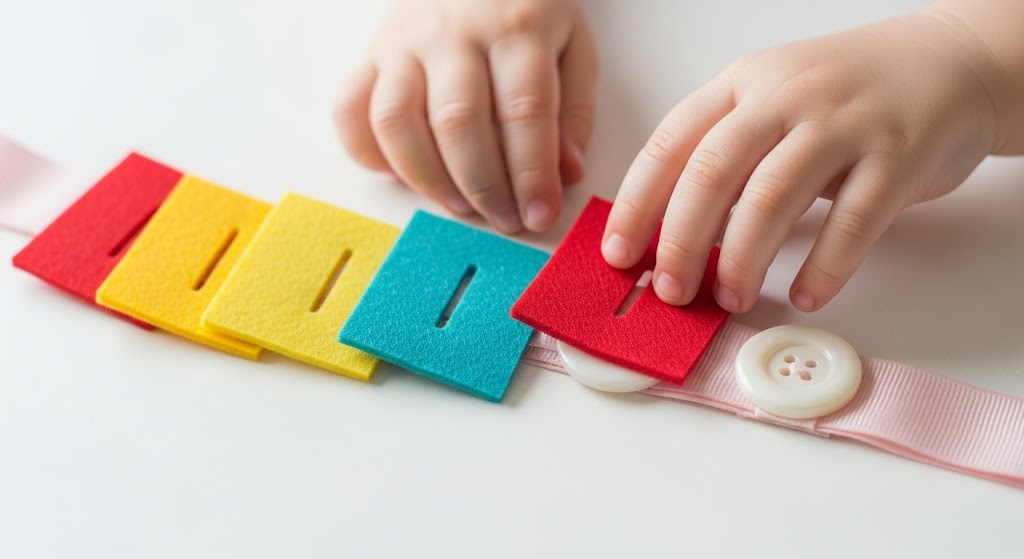
Sew a large button onto one end of a soft ribbon.
Cut felt squares with a slit in the middle.
Show your child how to slide each felt piece over the button.
They’ll love threading the pieces and feeling the soft fabric.
It builds fine motor skills without any small loose parts or cleanup.
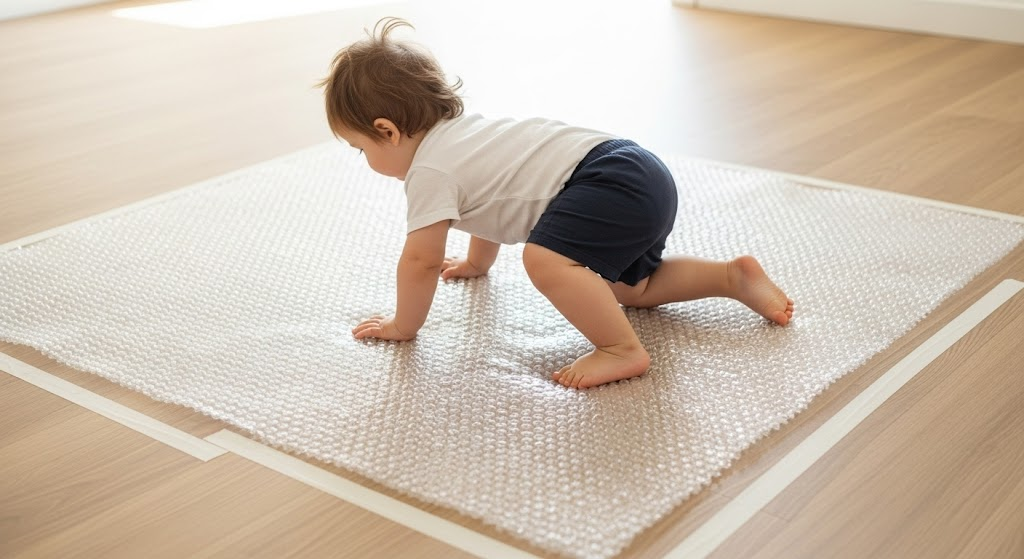
Tape a sheet of bubble wrap to the floor in a play area.
Let your toddler crawl or walk across it barefoot. Each step makes a gentle popping sound.
The texture feels different and exciting underfoot.
This activity gives sensory feedback through the feet without using any messy materials.
It’s simple, safe, and super fun.
Water play is a favorite for many toddlers.
These activities help your 1-year-old explore temperature, movement, and cause-and-effect relationships.
All of them use simple tools like cups, sponges, and toys.
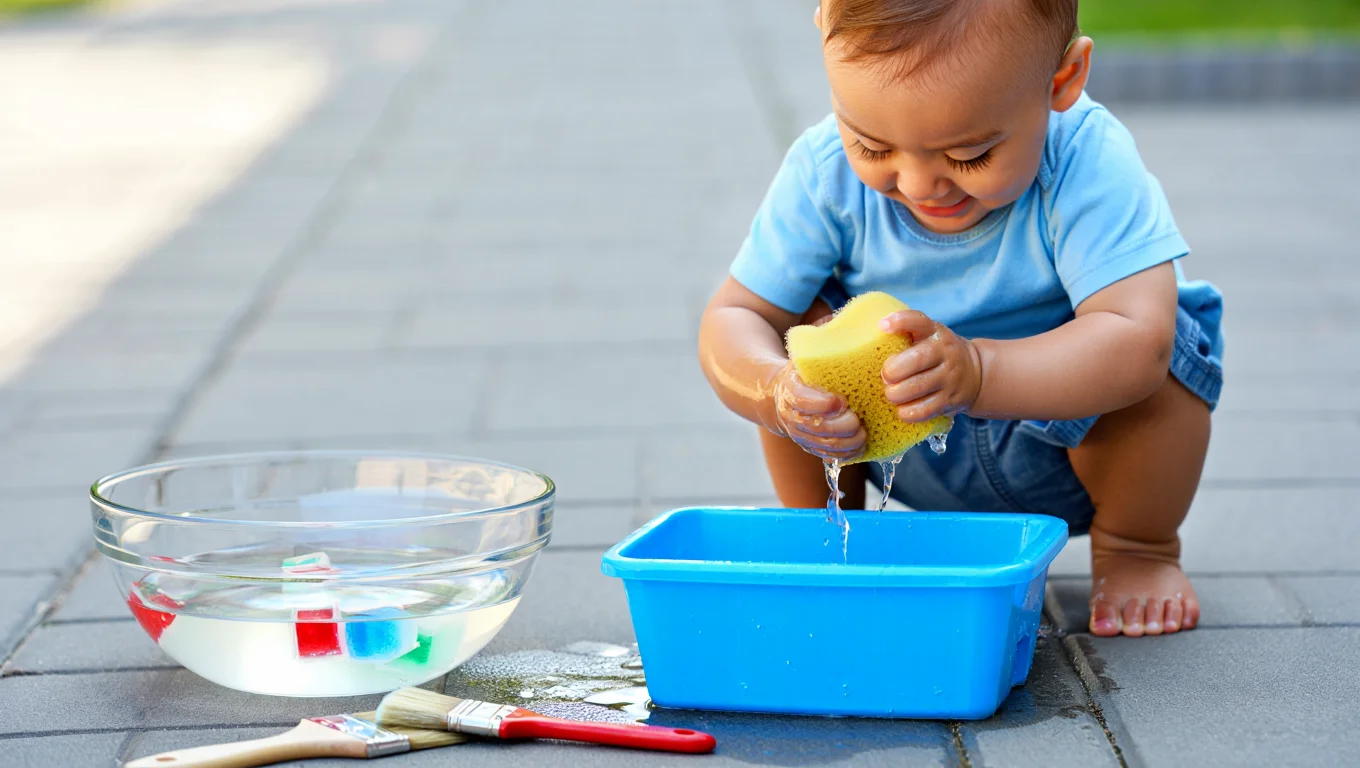
Set up a small bin with soapy water. Add plastic toys and a sponge or cloth.
Show your toddler how to wash the toys.
They’ll love dipping and scrubbing.
The water feels soft, and the bubbles are fun to watch.
This activity encourages helpful habits while building fine motor skills.
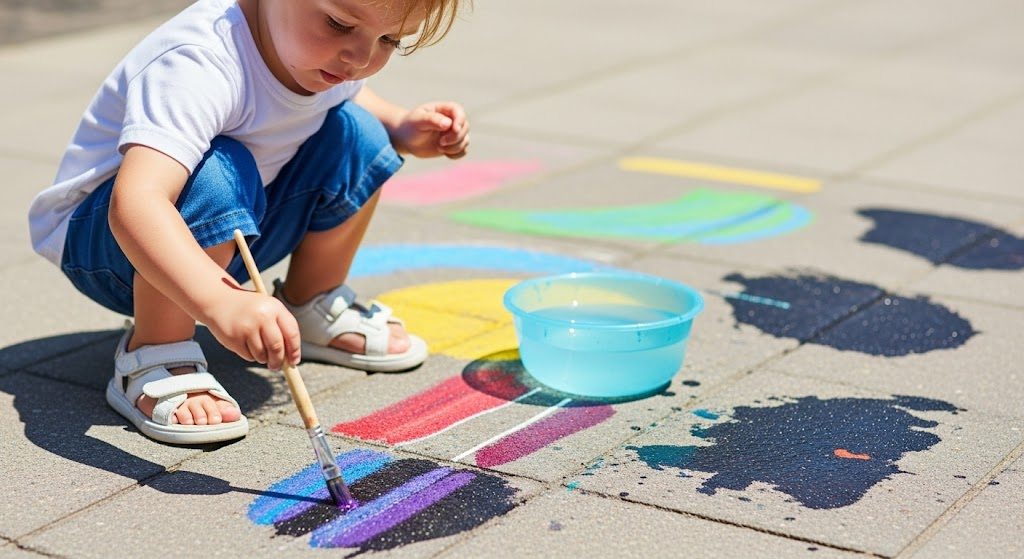
Give your child a bowl of water and a paintbrush.
Let them “paint” on the sidewalk or driveway.
The water makes dark marks that fade as they dry.
It’s mess-free and fun to watch the marks disappear.
This activity encourages creativity and helps with early hand movements.
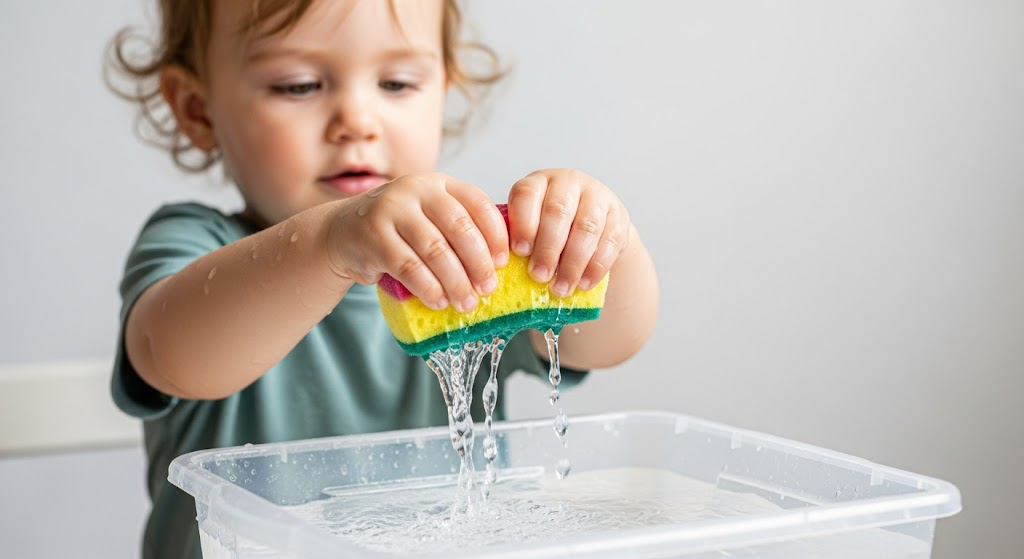
Fill a small bin with water and give your child a soft sponge.
Let them dip, squeeze, and soak it again and again.
They can watch the water drip and feel the sponge grow heavy.
It strengthens tiny hands and teaches how water moves and feels in fun ways.
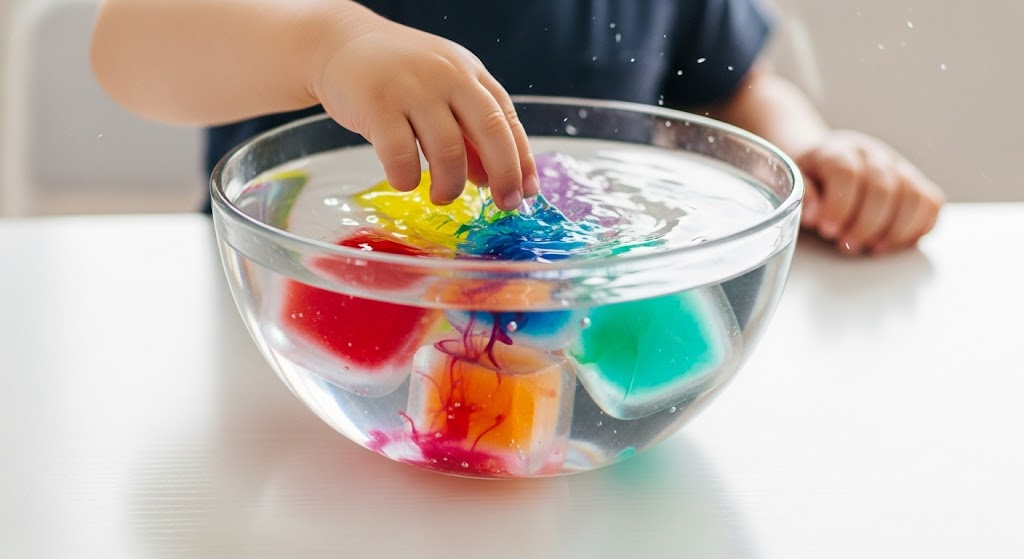
Drop a few ice cubes into a bowl of warm water.
Let your toddler touch, swirl, and watch them melt.
The cold and warm mix is exciting to feel.
You can even color the ice cubes for more fun.
It’s a great way to explore temperature and change.
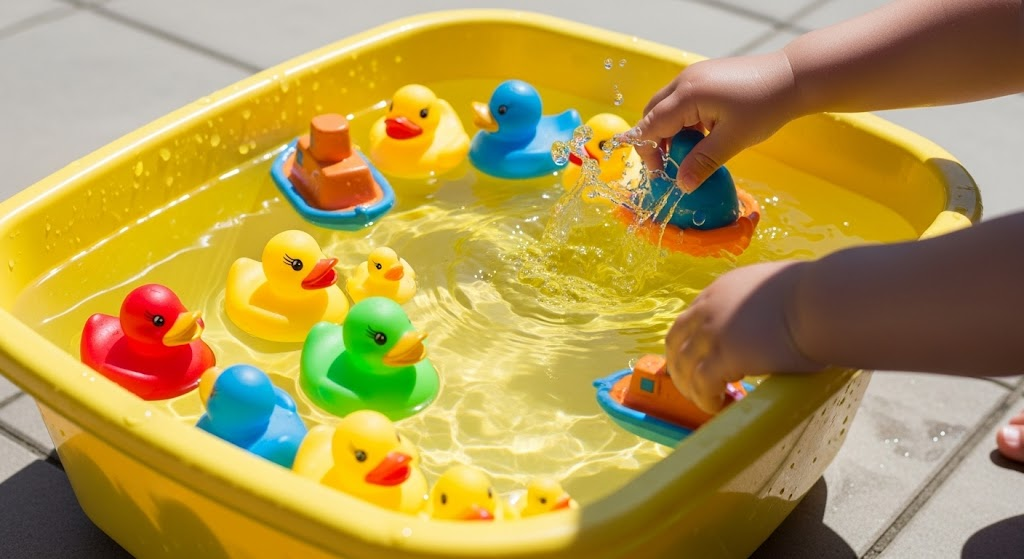
Fill a small tub or bin with water.
Add floating toys like rubber ducks or small boats.
Your child can splash, push, and scoop them around.
This play builds curiosity about floating and sinking.
It’s also relaxing and fun during bath or outside time.
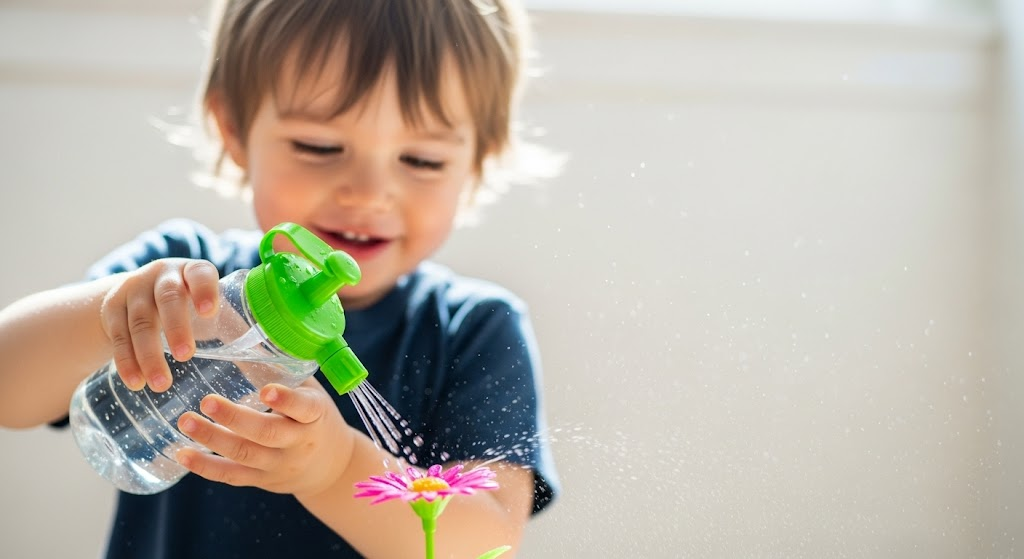
Fill a small squeeze bottle with water.
Show your toddler how to press and spray onto toys or plants.
They’ll enjoy the spraying action and the feel of water mist.
This activity builds hand muscles and teaches action and result in a playful way.
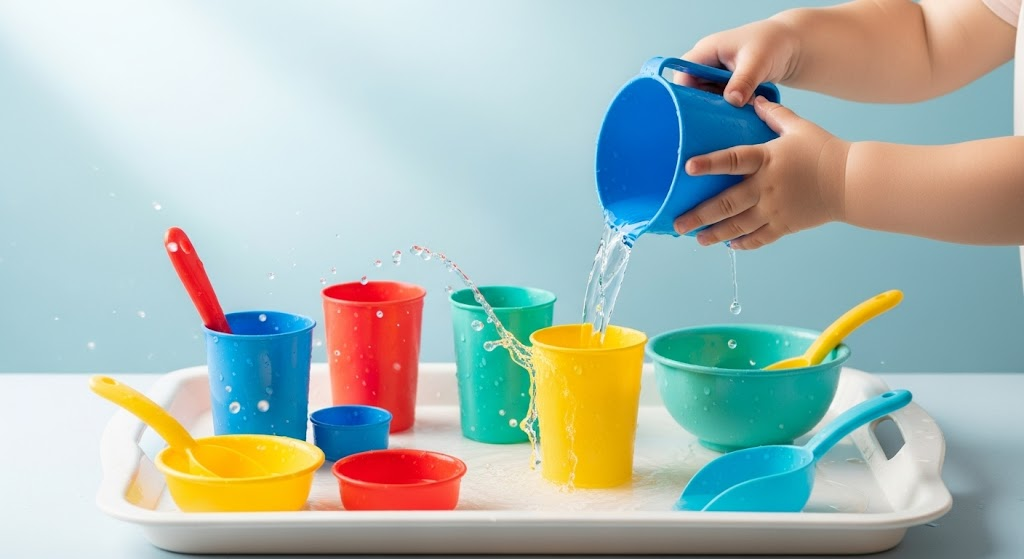
Give your child cups, scoops, and bowls filled with water.
Let them practice pouring from one to another.
Some spills are okay, it’s part of the fun. It builds coordination and focus.
This is a simple way to support early control and movement.
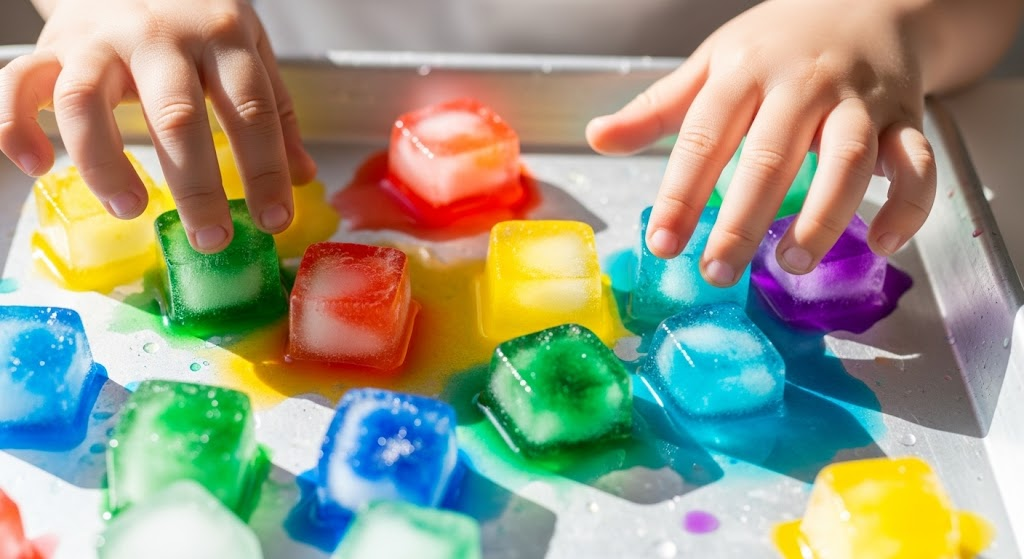
Make colored ice cubes using water and food coloring.
Let your child play with them in a shallow tray.
As the ice melts, colors blend and form patterns. It feels cold and looks pretty.
This activity teaches about melting and color mixing at the same time.

Put a little water in a bowl. Add a bit of soap to make bubbles.
Give your toddler a small whisk or spoon to stir and mix.
They’ll love watching the foam grow.
This simple task builds arm and hand strength while being bubbly and fun.
Nature offers amazing textures, sounds, and sights.
These outdoor sensory ideas allow your 1-year-old to explore safely while enjoying the fresh air.
They help your child build confidence, balance, and curiosity using everyday elements like grass, leaves, and stones.
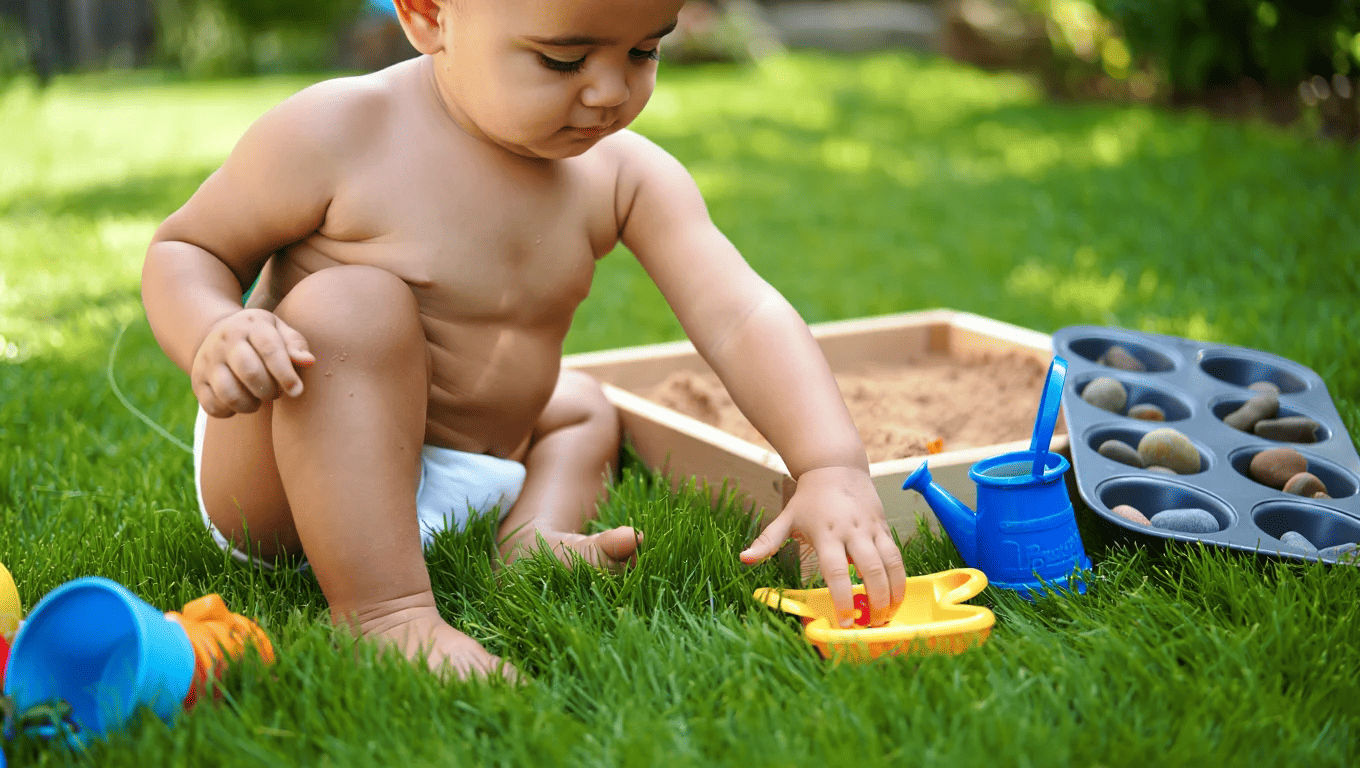
Let your toddler sit or crawl on clean grass.
They’ll feel soft, tickly blades on their hands and feet.
You can place toys nearby to encourage movement.
The texture is new and exciting.
It helps babies learn through touch while enjoying a calm outdoor setting.
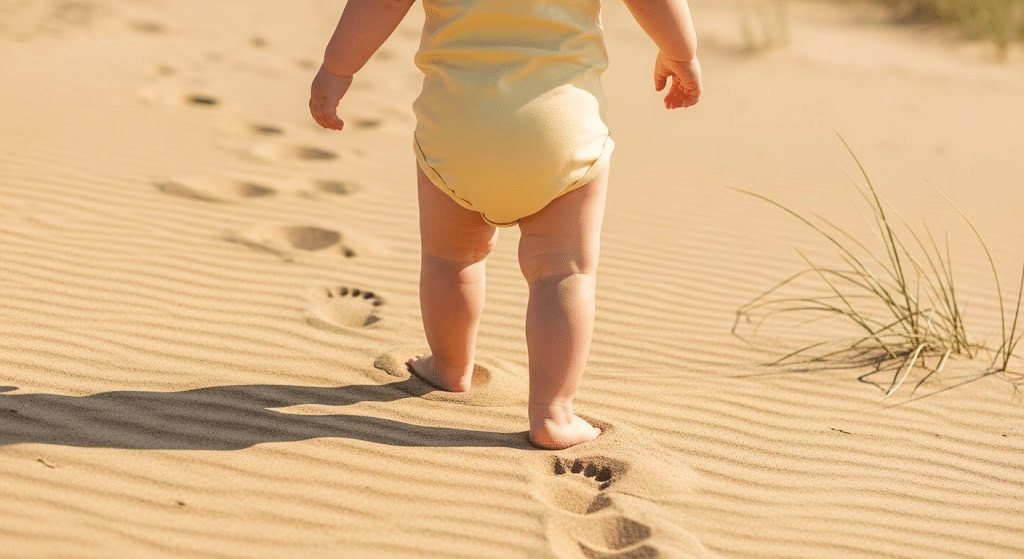
Find a sandbox or patch of soft sand. Let your child walk or stand barefoot.
They’ll feel the tiny grains between their toes.
Walking on sand helps improve balance and foot strength.
It’s also a gentle way to explore nature with each step.
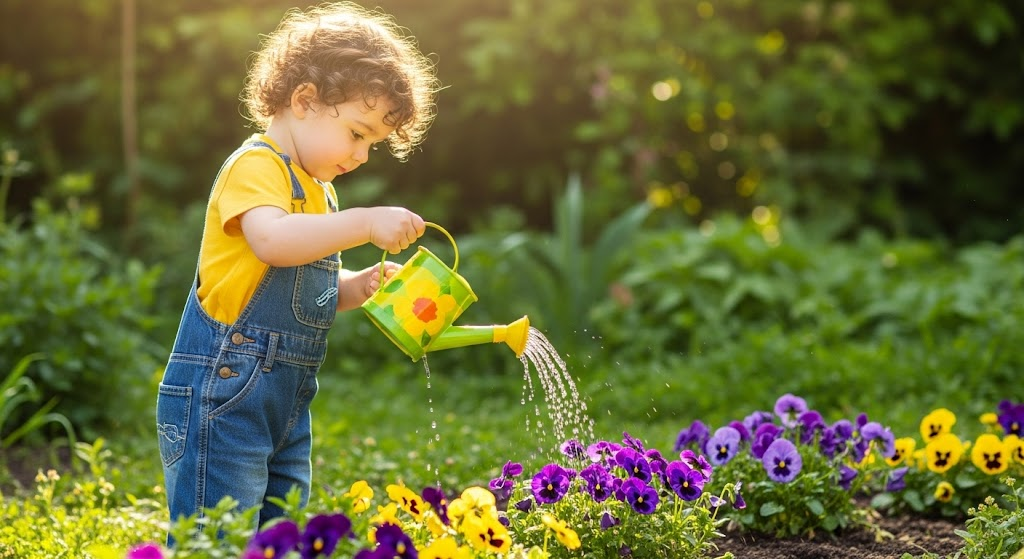
Give your toddler a small watering can filled with water.
Show them how to water flowers or garden plants.
They’ll enjoy tipping the can and watching the water fall.
This teaches cause and effect and builds care for living things while strengthening arms and hands.
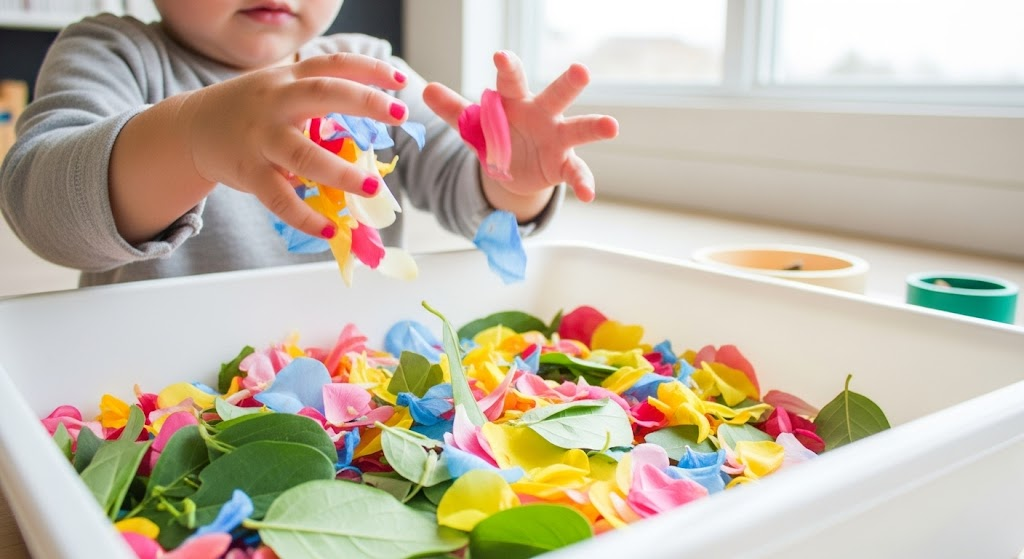
Collect soft flower petals and safe leaves.
Place them in a bin for your toddler to explore.
They can crush, sort, or toss them in the air.
The mix of shapes, colors, and scents makes this simple activity rich in sensory learning.
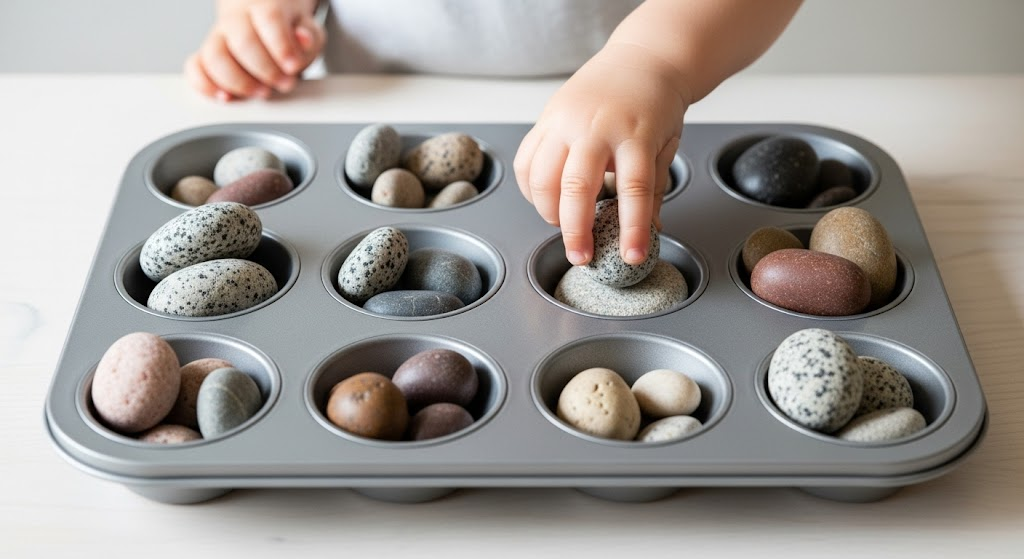
Gather smooth pebbles and a muffin tray.
Let your toddler sort pebbles into the cups by size or shape.
It feels fun to pick them up and drop them in.
This boosts hand-eye coordination and gives an early sense of grouping and order.
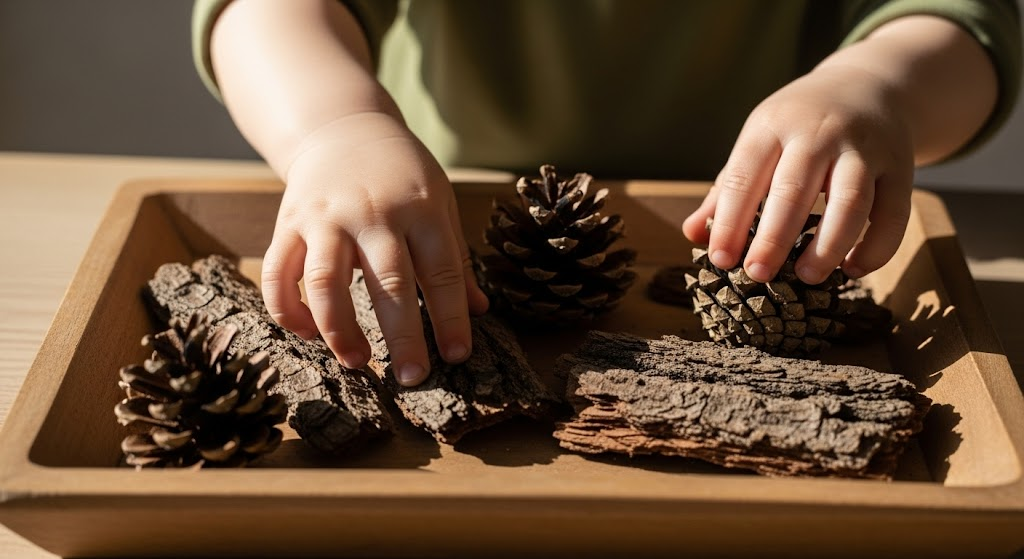
Place a few pinecones and tree bark pieces in a tray.
Let your child touch, turn, and smell each one.
The rough and bumpy surfaces feel new.
It’s a great way to introduce textures from nature while staying close to home.
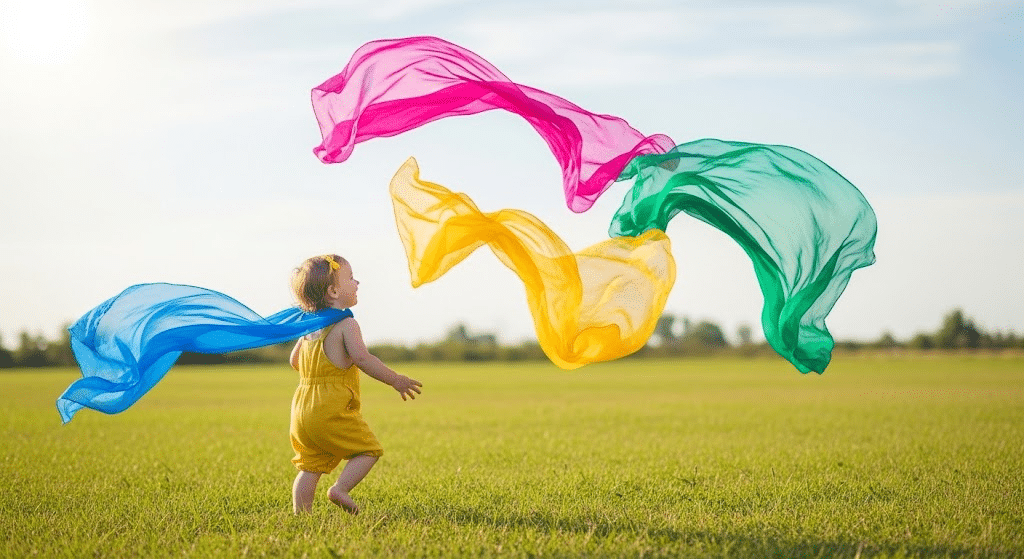
Bring a few lightweight scarves outdoors.
Hold them up and let the wind catch them.
Your toddler can chase or wave the scarves in the breeze.
It’s playful, calm, and teaches about wind through simple, gentle movement.

Sit quietly with your child in the yard or park.
Ask them to listen for the sounds of birds.
Point out different chirps and calls.
Even if they can’t name them, they’ll start to notice nature’s quiet sounds.
It builds awareness and early listening skills.
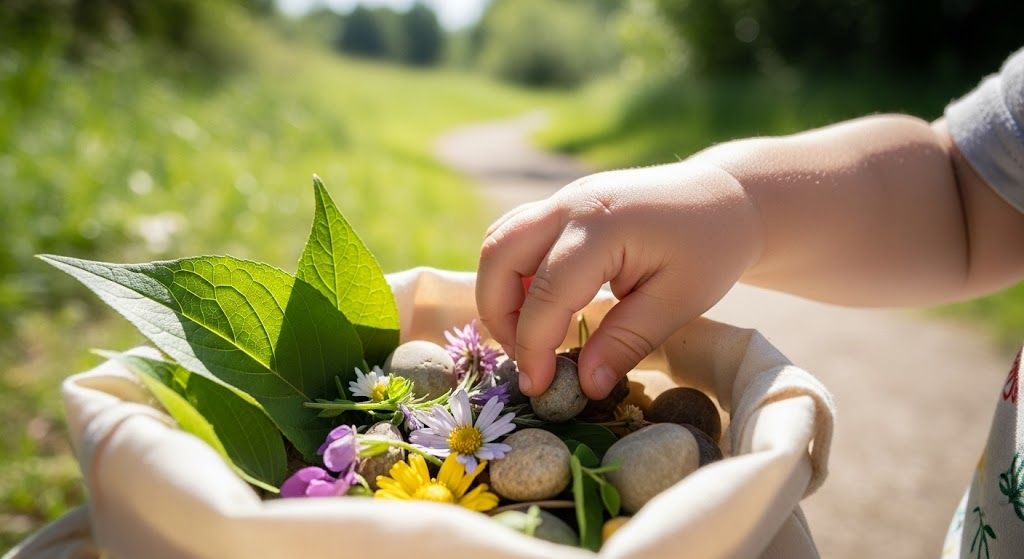
Fill a small cloth bag with natural items like leaves, stones, and flowers.
Let your toddler reach inside and feel each object one at a time.
Talk about how each item feels.
It turns a simple walk into a learning experience with real-world textures.
Tactile play helps toddlers understand the world through touch.
These activities introduce different textures, such as soft, rough, bumpy, or fluffy.
They help improve finger strength, coordination, and curiosity.
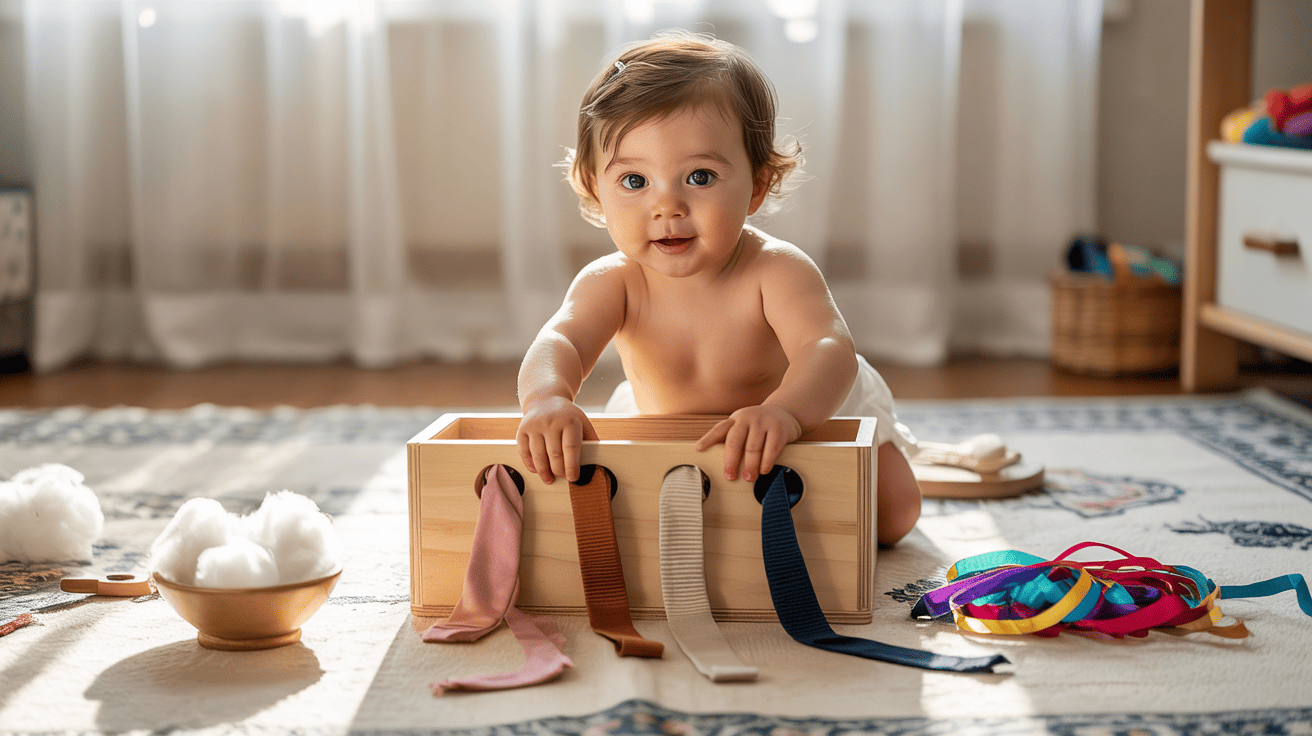
Cut holes in a cardboard box and thread fabric strips through them.
Use soft, bumpy, and silky textures.
Your toddler can pull them out and feel the difference.
It’s easy to set up and keeps them interested.
This activity builds hand strength and introduces new materials in a fun way.
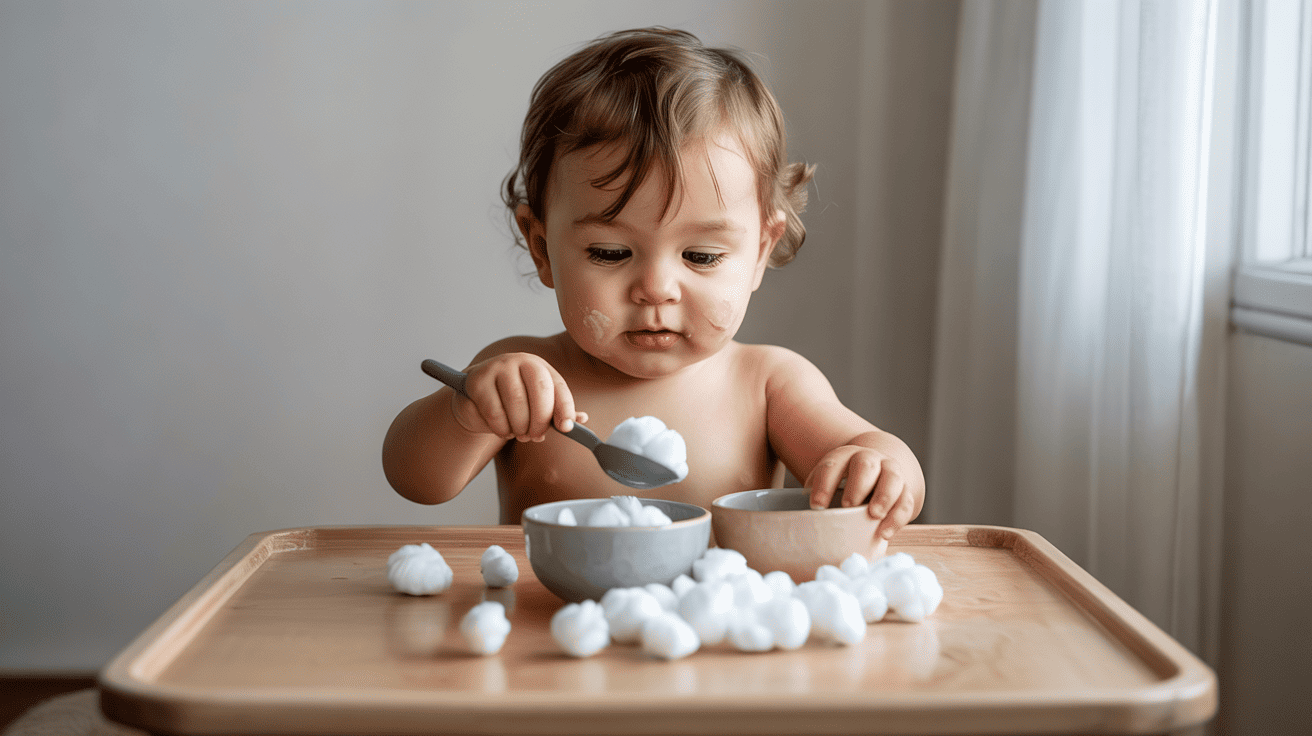
Fill a bowl with cotton balls. Give your toddler a spoon and another empty bowl.
Show them how to scoop and transfer.
The cotton balls are light and fluffy, making this both easy and fun.
It enhances hand-eye coordination and grip while providing a soft texture for exploration.
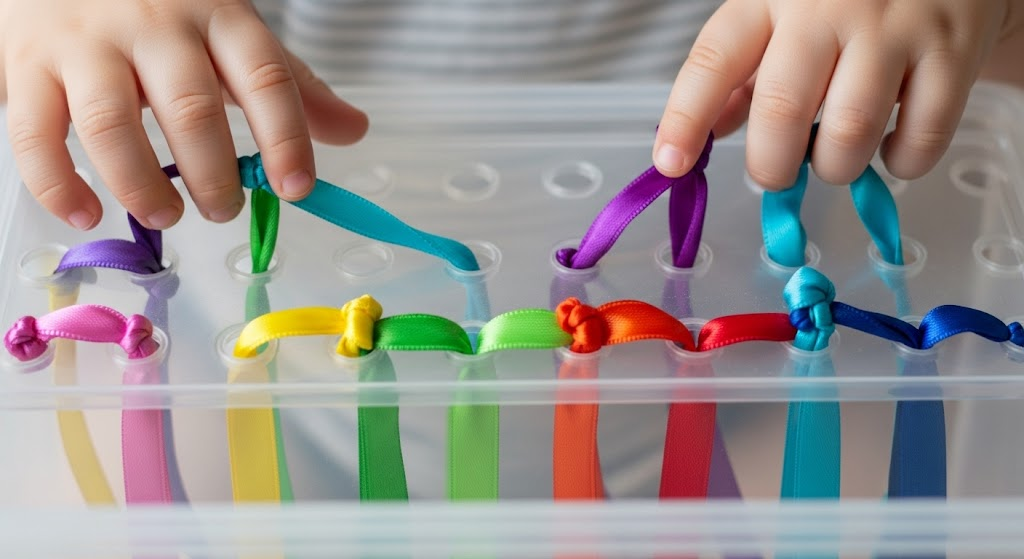
Place long ribbons through small holes in a container or lid.
Tie knots so they don’t fall out.
Let your toddler pull and push the ribbons through the holes.
The smooth, slippery feel is exciting.
This helps with finger control and encourages playful problem-solving.
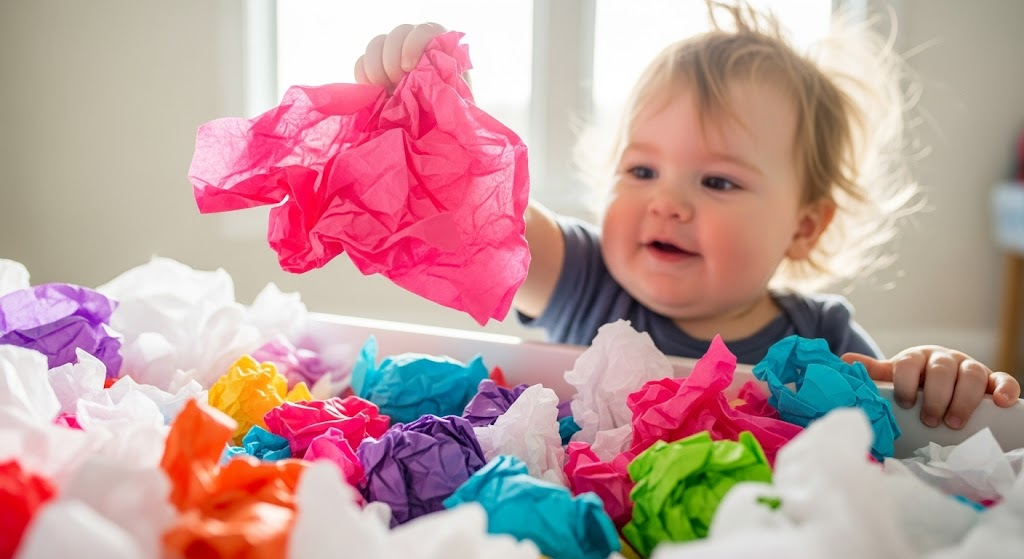
Fill a bin with crinkly tissue or wrapping paper.
Let your toddler crumple, grab, and wave it around.
The sound is fun, and the texture is new.
It’s great for building sensory interest and fine motor skills, with the added bonus of sound to keep them engaged.
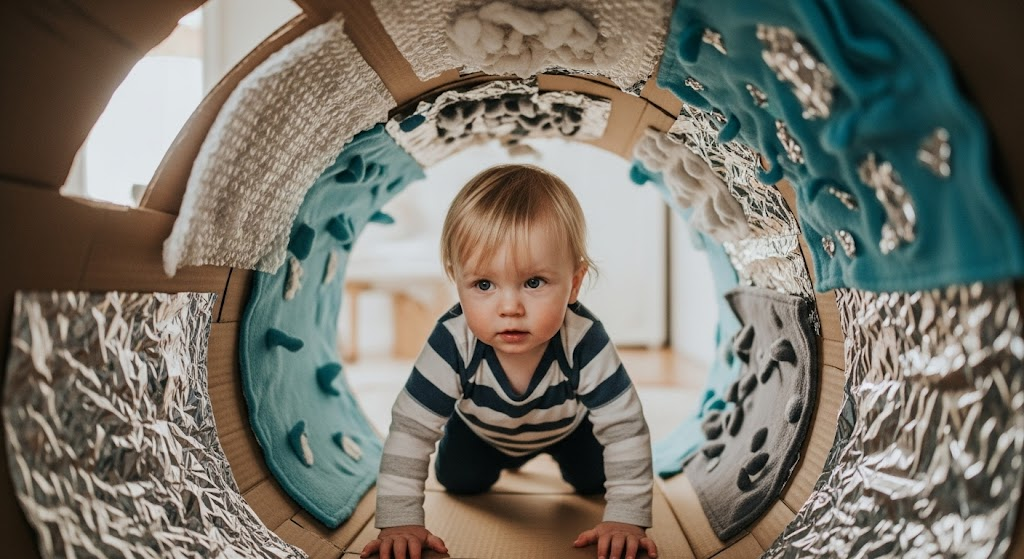
Create a short tunnel using cardboard or a soft play tunnel.
Line the inside with different fabrics like fleece, foil, or bubble wrap.
Let your toddler crawl through and touch the textures.
It’s fun and great for full-body movement.
It encourages exploration and builds body awareness.
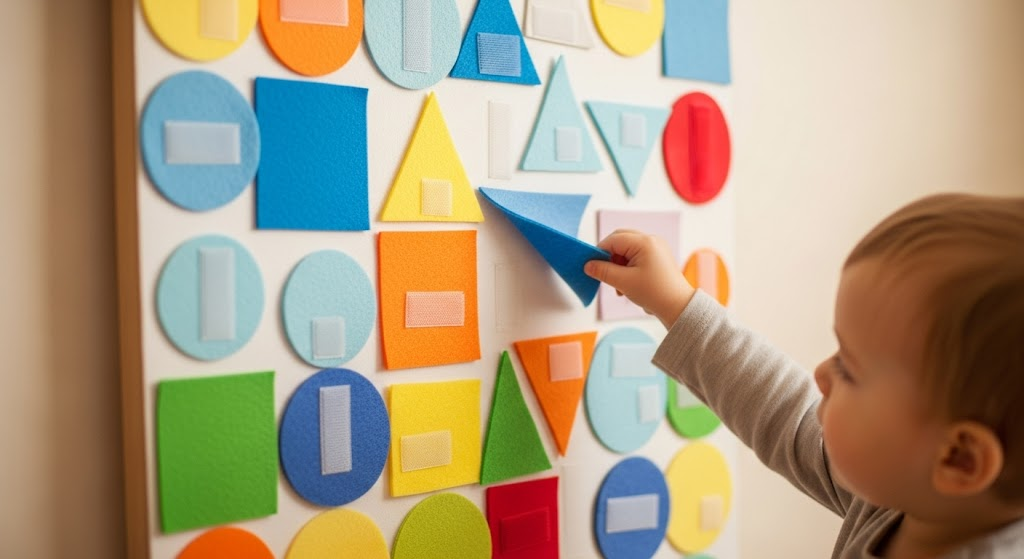
Stick felt pieces to a wall or board using Velcro or tape.
Use different shapes, sizes, and colors.
Your toddler can touch, move, and pull them off.
The soft texture feels nice, and they’ll enjoy matching or stacking.
It supports shape learning and tactile play at once.
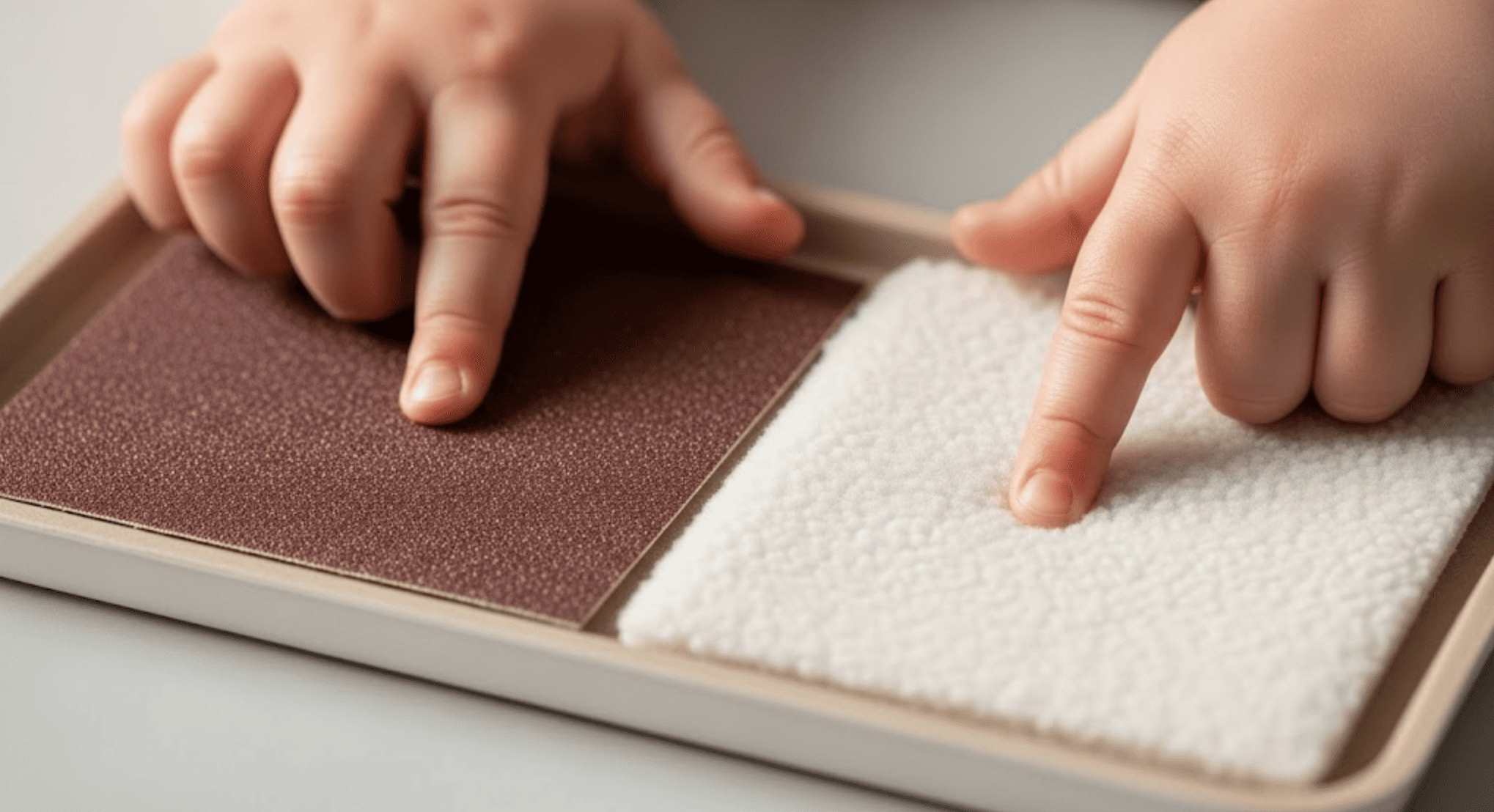
Tape small pieces of sandpaper and fleece to a board or tray.
Let your child touch each one and feel the difference.
Ask which is rough and which is soft.
This simple activity builds texture awareness and gives early language tools to describe how things feel.
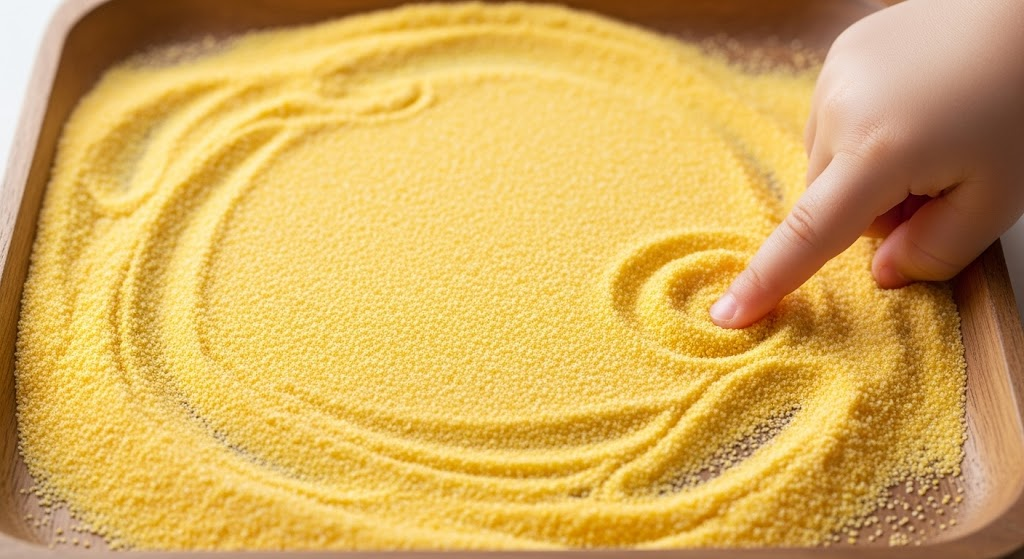
Pour cornmeal into a shallow tray.
Show your toddler how to draw shapes or lines using a finger.
The fine texture feels sandy and fun to move around.
This builds pre-writing skills while giving them a calm, focused sensory experience they’ll enjoy repeating.
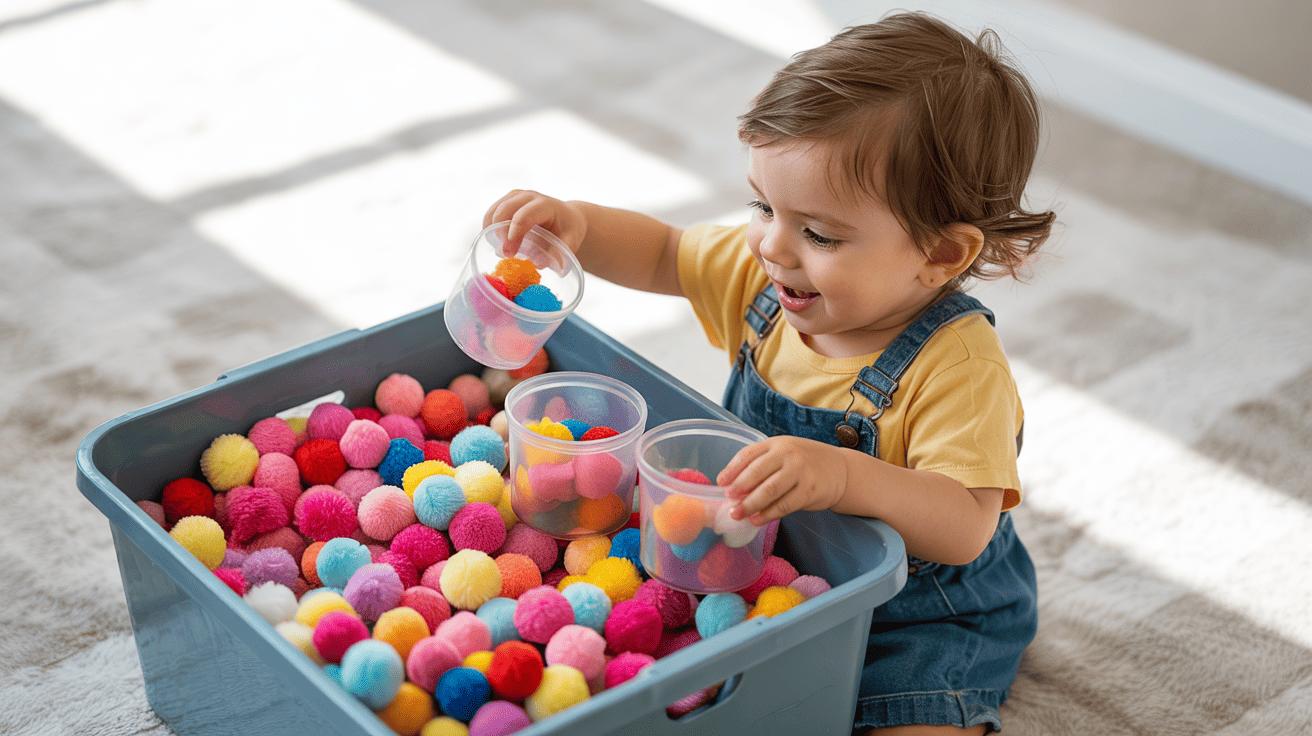
Fill a bin with soft pom-poms and add small scoops or cups.
Let your child scoop and dump the pom-poms into containers.
The light, fuzzy feel is soothing.
It’s a great way to practice hand movements and early sorting skills with no mess at all.
These sound-based activities help toddlers explore hearing in fun and playful ways.
Your 1-year-old will enjoy shaking, tapping, clapping, and listening.
These games support early speech, rhythm, and sound recognition.
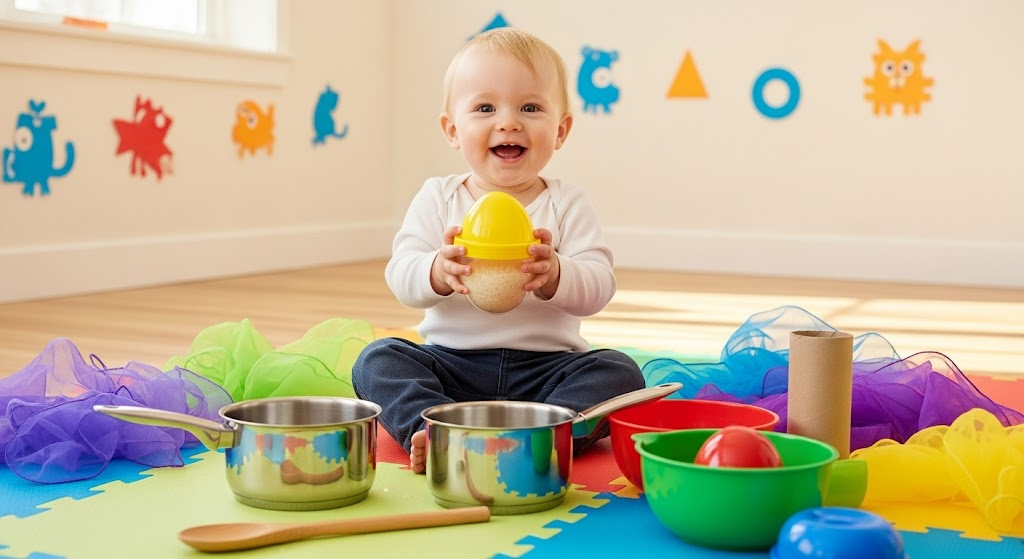
Fill plastic eggs with rice or pasta and seal them tightly with tape.
Let your toddler shake them to hear the sound.
You can make several with different fillings. Each makes a slightly different noise.
This activity builds rhythm, grip strength, and introduces cause and effect in a fun, safe way.
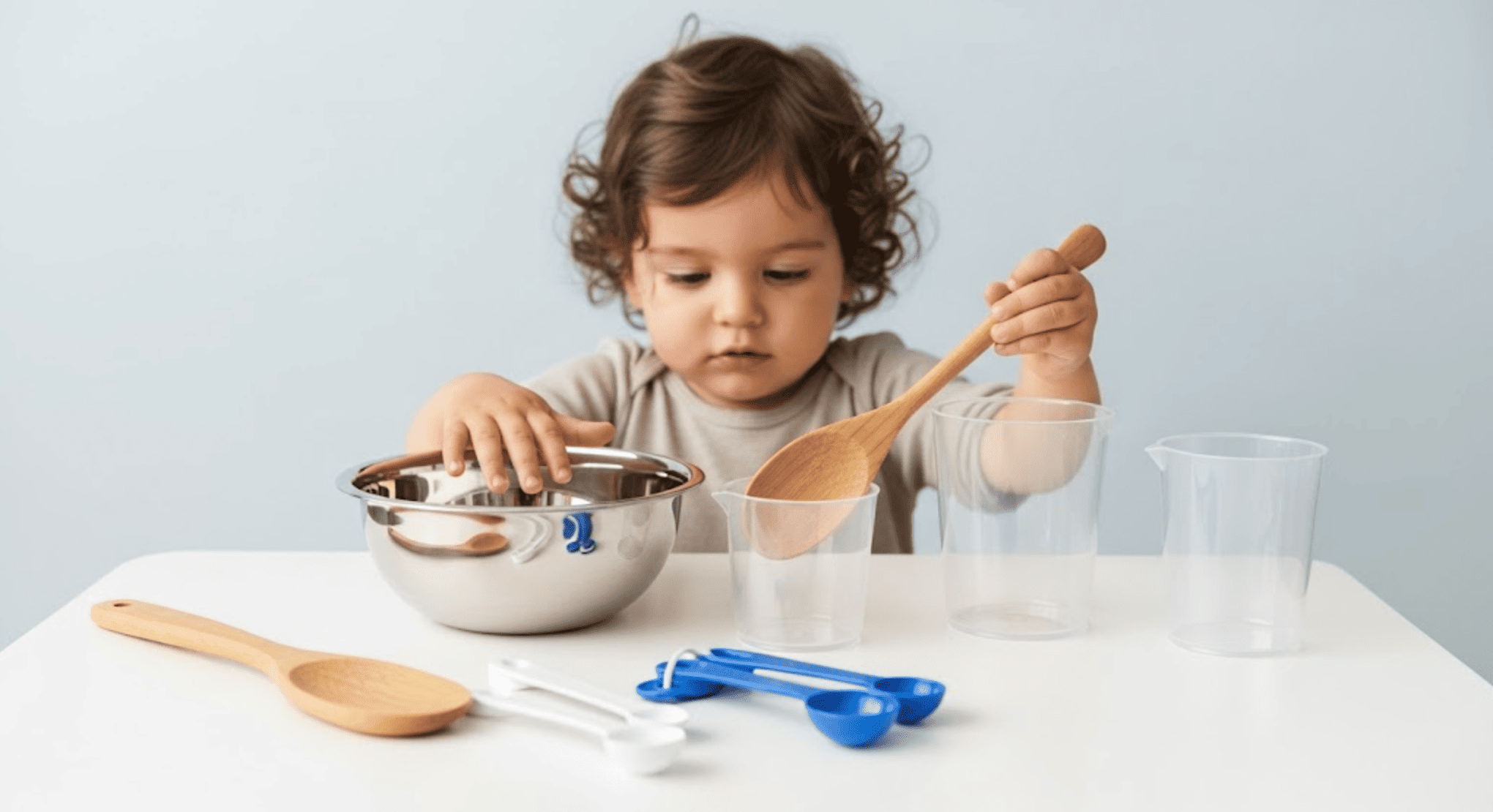
Gather safe kitchen tools, some metal, and some plastic.
Let your toddler bang or tap each one using a wooden spoon.
They’ll hear loud clinks from metal and soft thumps from plastic.
This activity teaches sound differences and supports curiosity about everyday items.
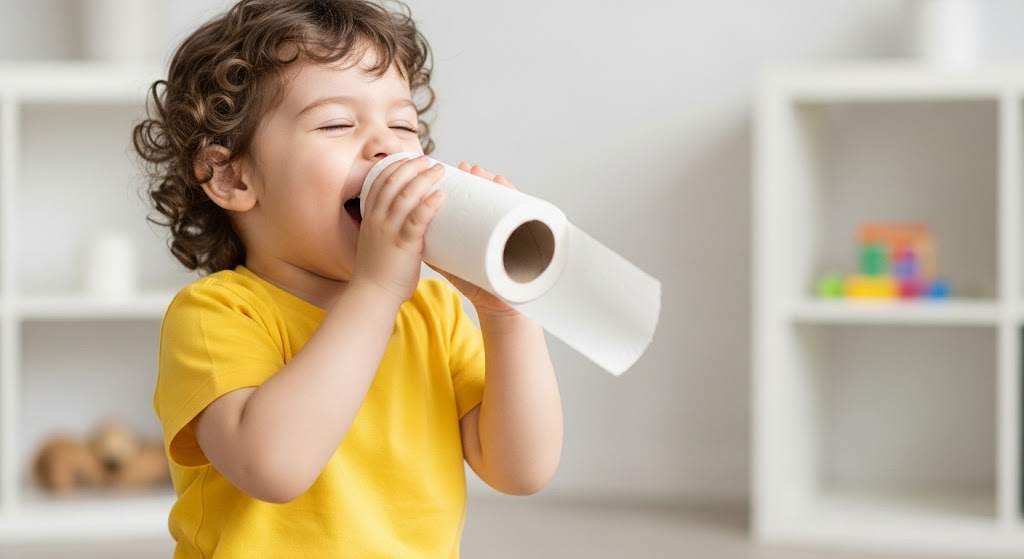
Give your child an empty paper towel roll and sing or talk into it.
Let them try too. The sound echoes slightly, making voices sound funny.
It helps them learn about sound vibration and echo.
Plus, it builds confidence in using their voice while playing.
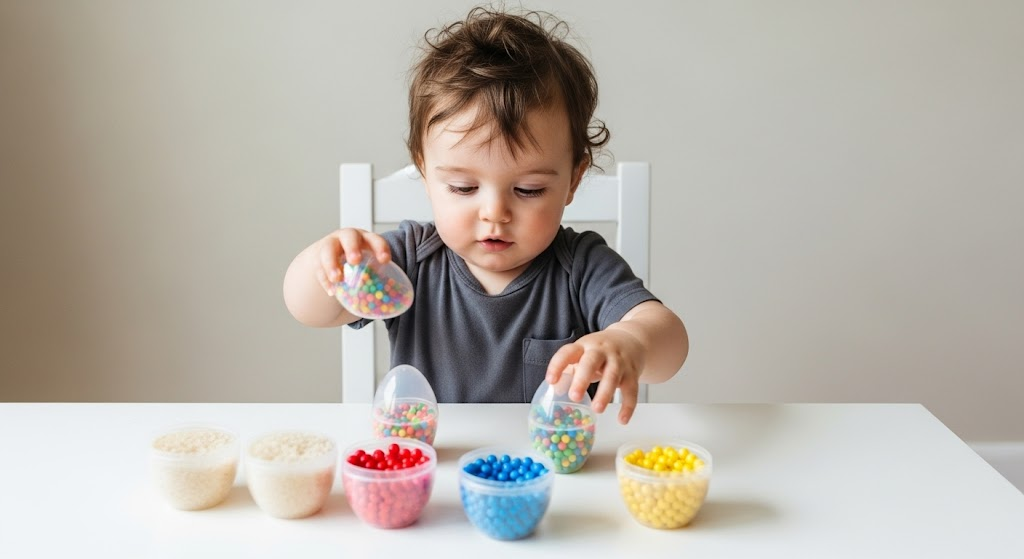
Fill two sets of containers with matching items like rice, beads, or buttons.
Shake one, and let your child find the container that makes the same sound.
It’s a simple listening game that sharpens memory and sound recognition in a playful, hands-on way.

Play soft music and give your child a lightweight scarf.
Show them how to wave, swirl, and toss it in time with the beat.
The movement and music together build rhythm awareness, balance, and coordination while keeping things light and joyful.
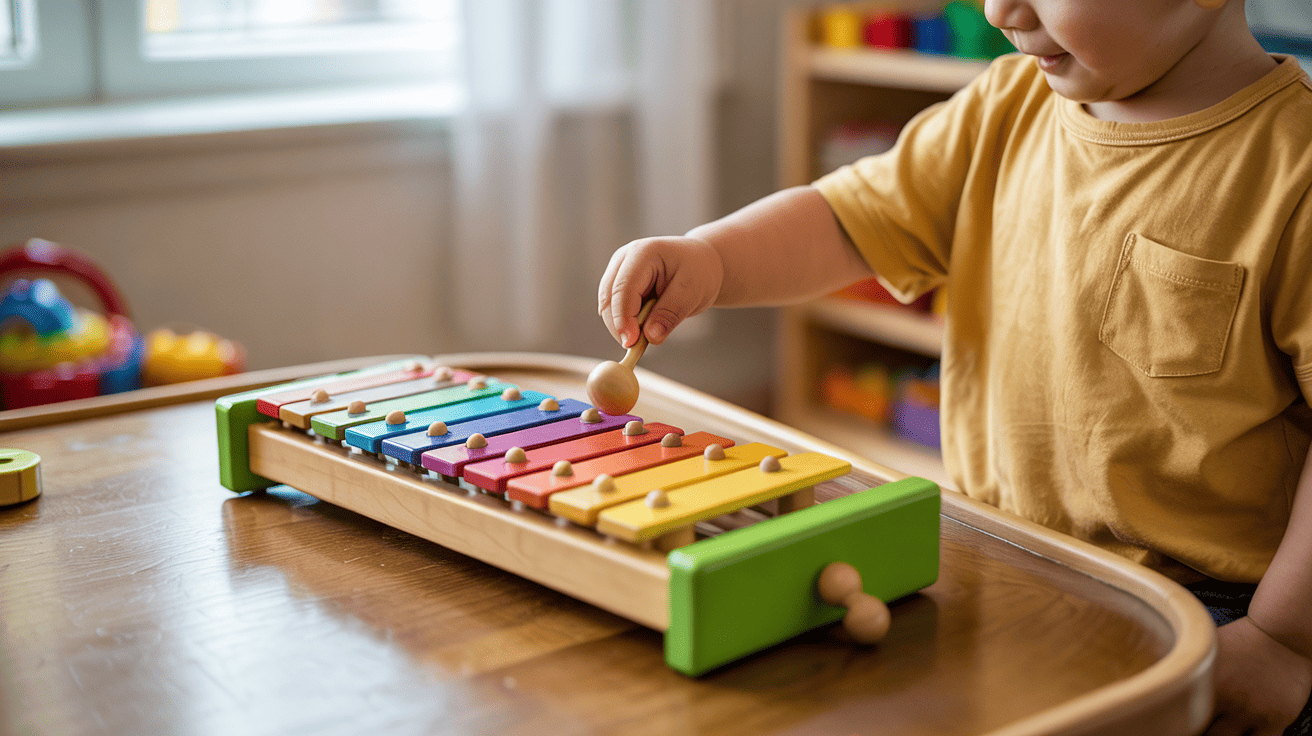
If you have a toy xylophone, let your toddler tap it using a wooden spoon.
They’ll enjoy hearing the different notes.
It’s a great way to explore high and low sounds.
This activity introduces music in a gentle, colorful way that supports hand-eye coordination.

Take your toddler on a quiet walk. Pause often and listen together.
Point out birds, cars, or wind sounds.
You can ask simple questions like, “Did you hear that?”
It builds attention, patience, and awareness of the world through sound finding.

Clap a simple rhythm with your hands and have your child copy it.
Start slow with one or two claps. Then build up.
This helps your child listen closely and repeat patterns.
It’s also a fun way to improve focus, memory, and coordination.
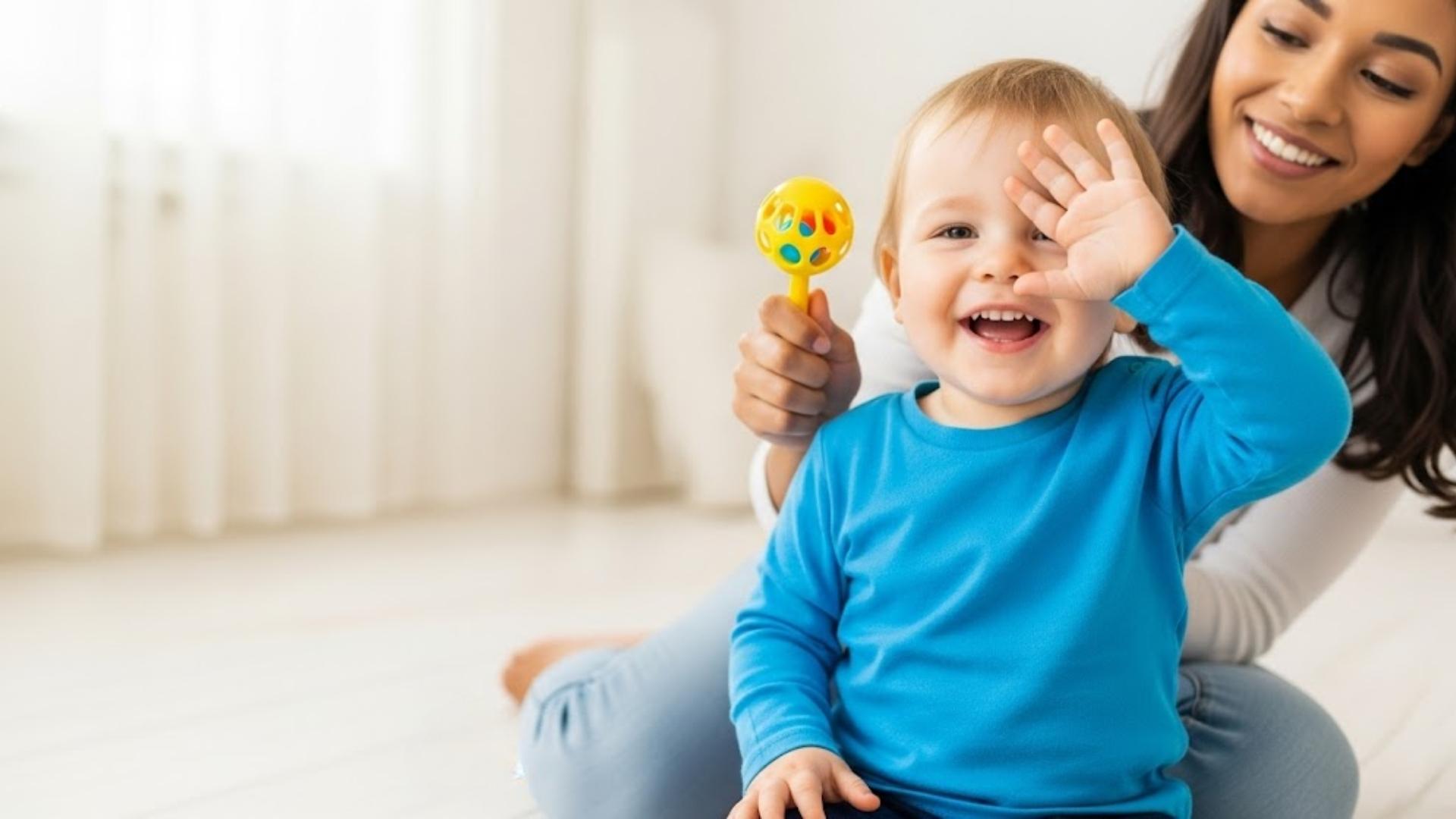
Shake a rattle behind your back, then shake a jingle bell.
Let your child guess which one they heard, then show them the answer.
Switch turns if they want.
This activity teaches sound differences and builds early listening and guessing skills with fun surprises.
These visual activities help your 1-year-old explore shapes, light, and color in fun ways.
Bright objects, mirrors, shadows, and glowing items grab their attention and build visual tracking skills.
These playful ideas also support early creativity, problem-solving, and focus.
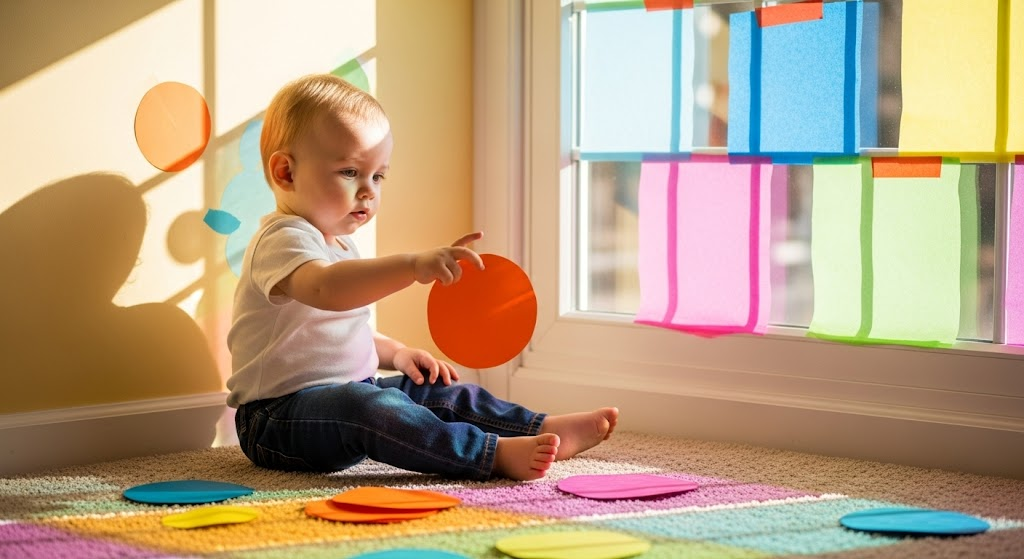
Cut out large paper shapes and place them near a sunny window.
Show your toddler how shadows form on the floor or wall.
Move the shapes around and let them try too.
Watching shadows shift and stretch builds curiosity and introduces basic light concepts in a fun, hands-on way.
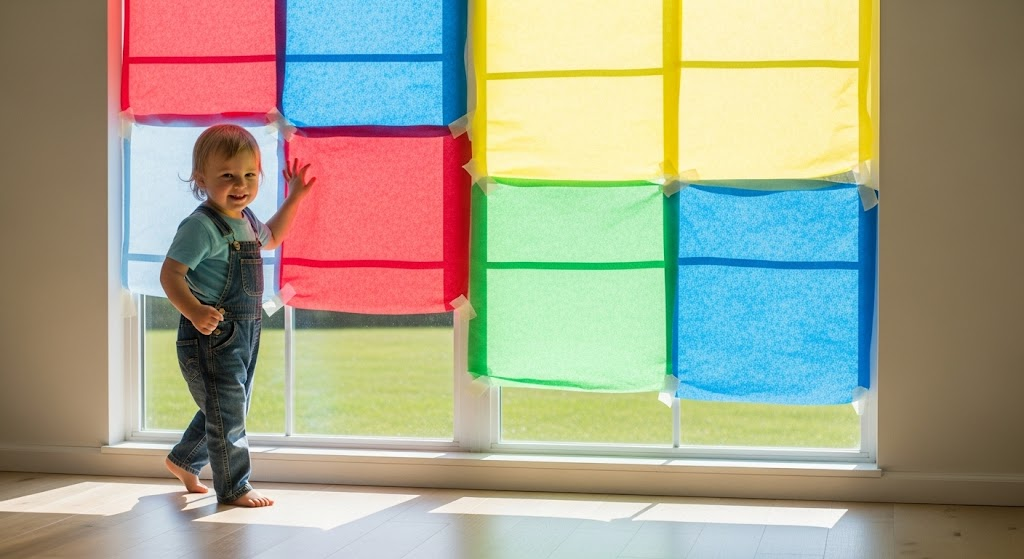
Tape colored tissue paper onto a sunny window.
When sunlight shines through, it creates soft, glowing colors on the floor or wall.
Let your toddler look through the colors or walk past them.
It’s simple, beautiful, and helps them explore how light changes color and mood.
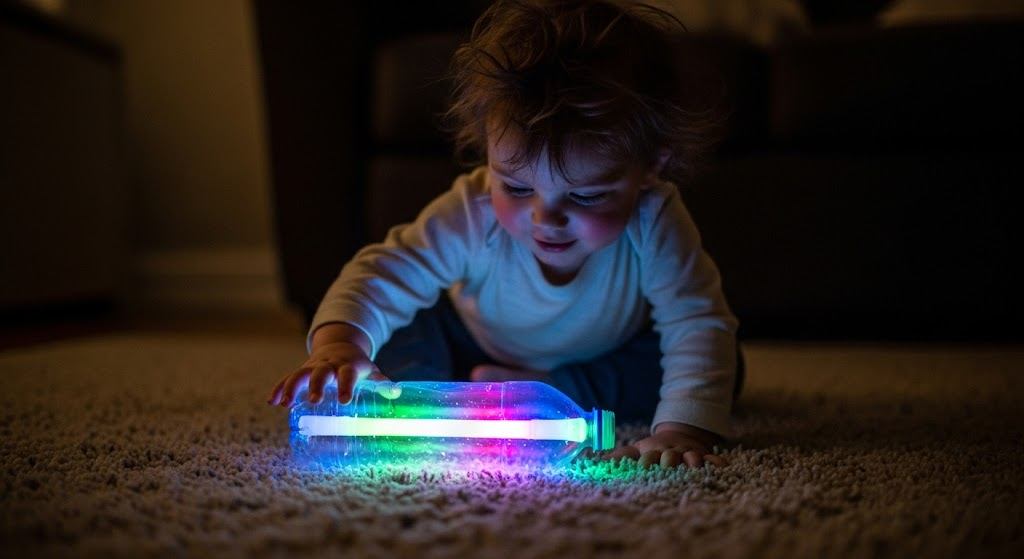
Place an activated glow stick into a clear plastic bottle filled with water, seal it tightly.
Turn off the lights and let your child shake and roll it.
The glowing colors and moving bubbles are calming to watch.
It’s great for quiet time and helps develop visual focus.
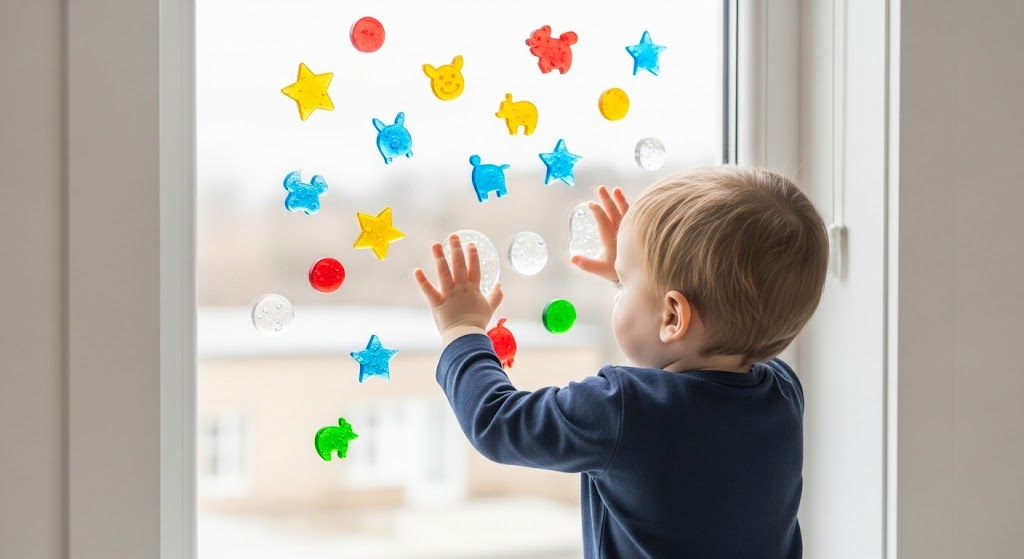
Stick soft gel clings to a clean window at your child’s height.
They can press, pull, and move the shapes around.
The squishy feel and bright colors make this both tactile and visual.
It supports hand control, color recognition, and safe, mess-free creativity.
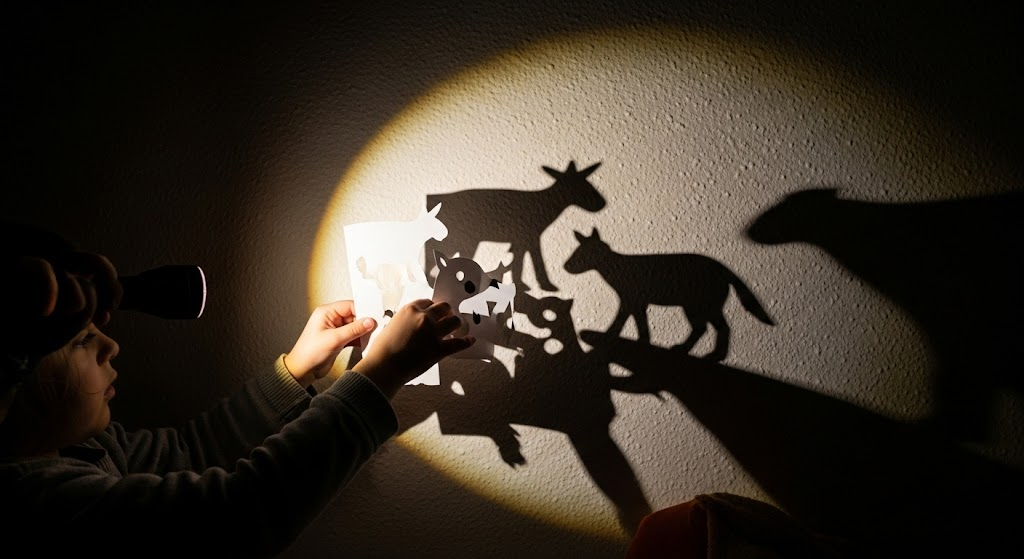
Turn off the lights and shine a flashlight on a wall.
Use your hands or paper cutouts to make shadows.
Your toddler can watch the shapes move or try making their own.
This game builds attention and encourages cause-and-effect learning through light and shadow play.
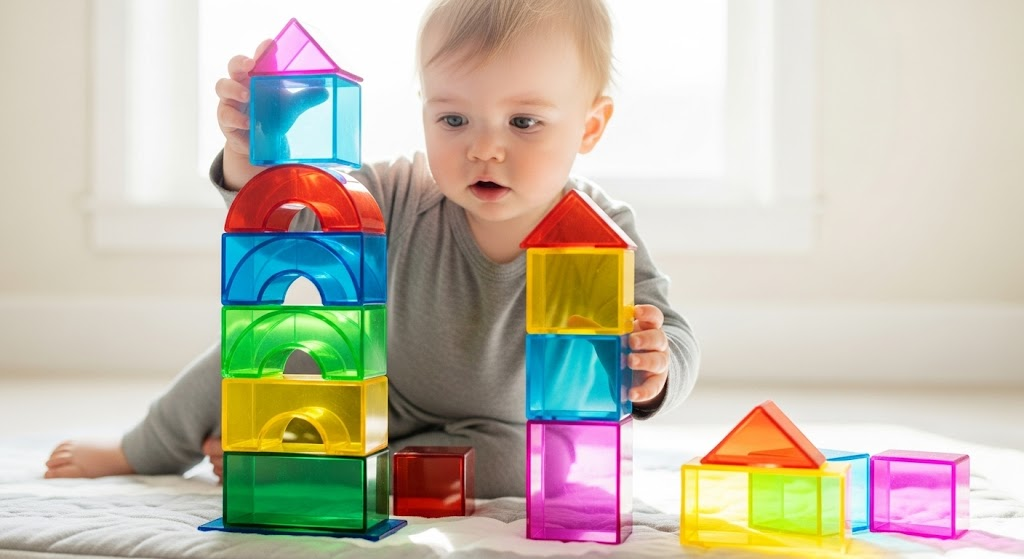
Give your toddler see-through stacking blocks in different colors.
As they build, the light shines through and mixes the colors.
It’s fun to look at and stack.
This activity encourages creativity, color mixing, and balance through simple play with bright, safe materials.

Place a baby-safe mirror on the floor or wall.
Let your toddler look at their face and make different expressions.
You can make silly faces together.
This helps them learn about emotions, movement, and identity, all while having fun seeing their reflection.
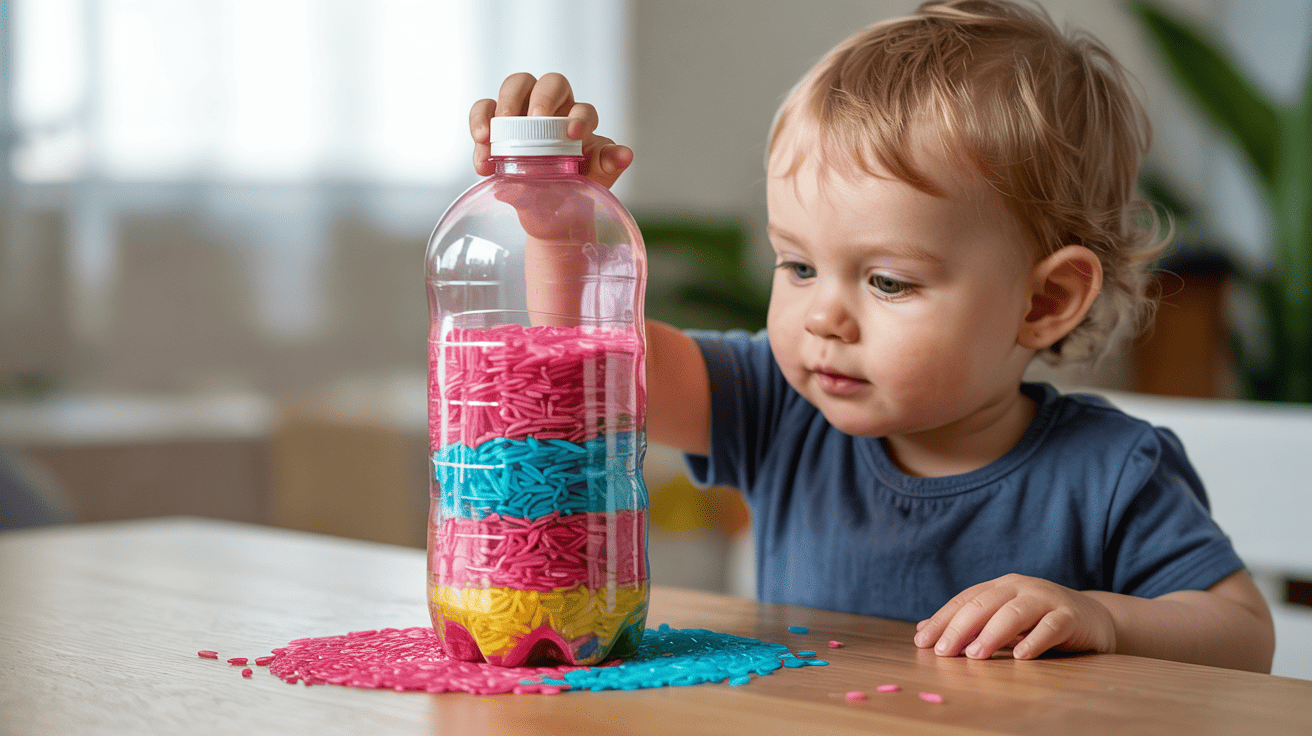
Fill clear plastic bottles with colorful dyed rice, and seal them tightly.
Let your toddler shake, roll, or turn them upside down.
The sound and color movements are fun to watch.
It’s a quiet, calming activity that boosts visual tracking and early color learning.
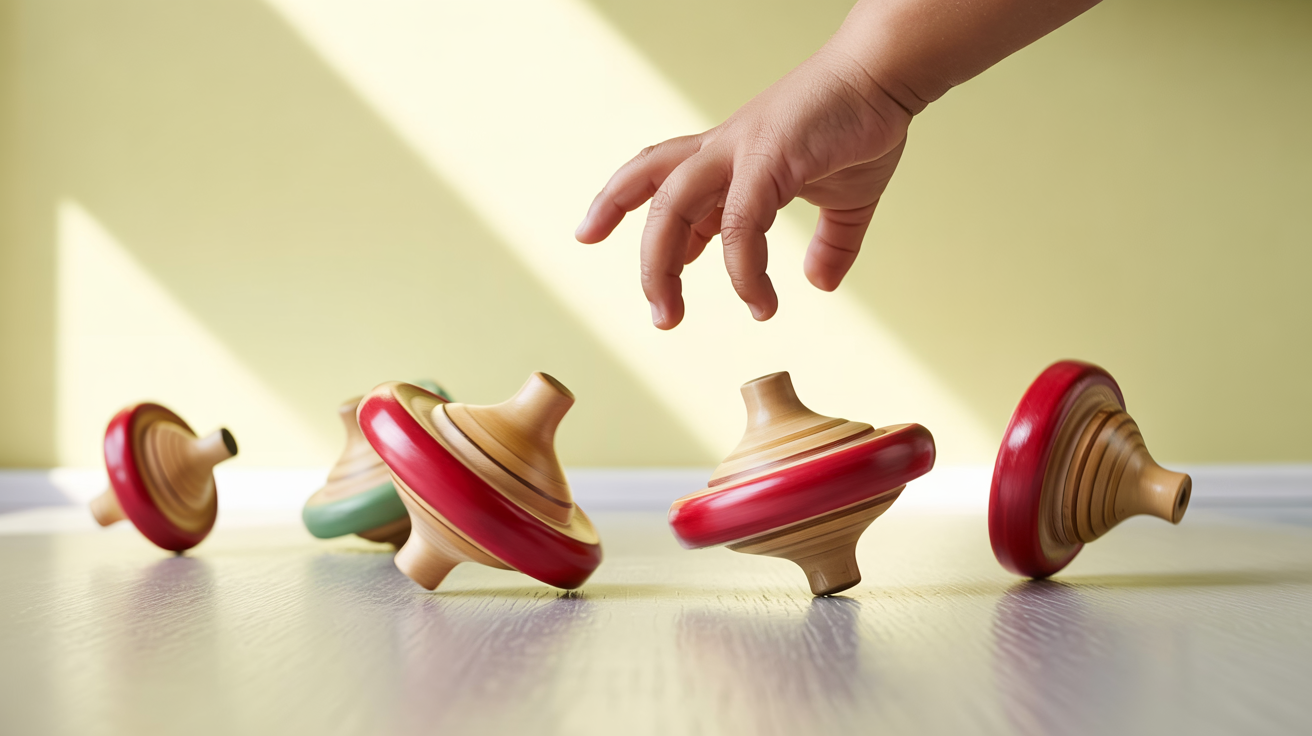
Give your toddler large, easy-to-hold spinning tops with bright colors.
Show them how to spin and watch the colors blend.
The motion grabs their attention and helps build hand strength and coordination.
It’s a great way to mix movement and visual fun.
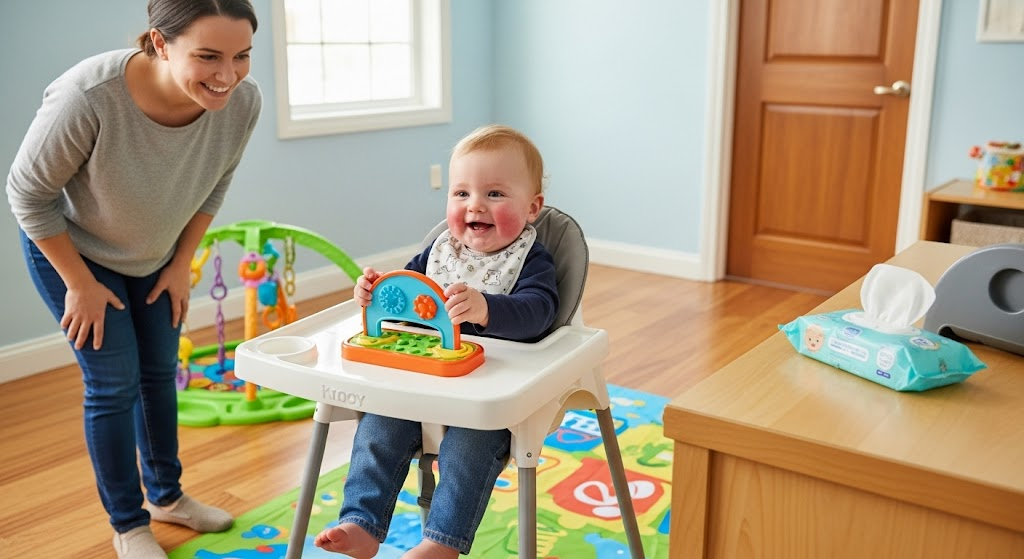
Setting up sensory play for your 1-year-old doesn’t need to be complicated.
With a few simple strategies, you can make these activities enjoyable while minimizing stress and mess.
Remember that the goal is to have fun together while learning.
Don’t worry if activities don’t go exactly as planned; sometimes, the unexpected findings lead to the best learning moments!
Sensory activities are amazing tools for helping your one-year-old grow and learn.
These simple, fun experiences build important skills while keeping your little one happy and engaged.
Remember, every baby develops at their own pace, so don’t worry if some activities work better than others.
The key is to stay patient, keep things safe, and follow your child’s lead.
Most importantly, have fun together!
These precious moments of discovery create lasting memories and strengthen your bond.
Whether it’s finger painting or playing with rice, you’re giving your baby the gift of exploration and learning through play.
Your baby’s next big find is just one sensory activity away!
What’s your toddler’s favorite sensory activity?
Share your chaotic ventures in the comments below!
Craving more baby-related content?
Explore everything we offer on .










